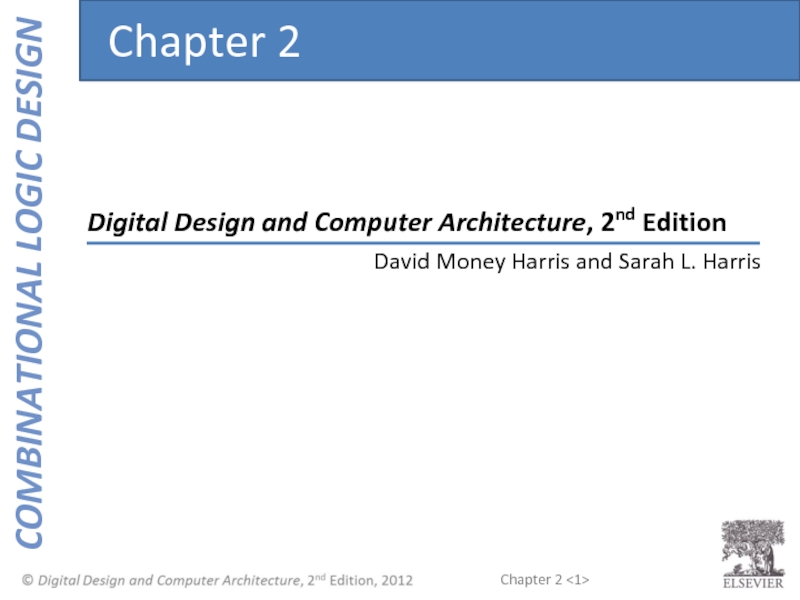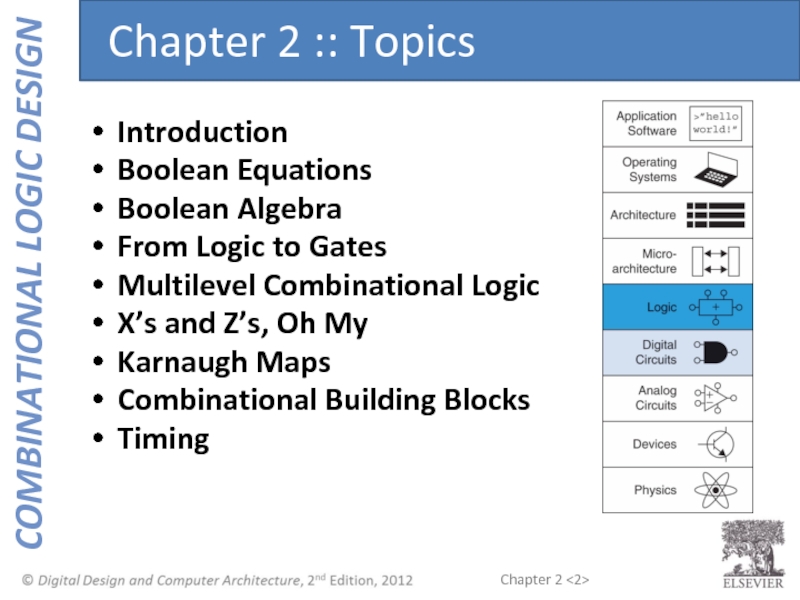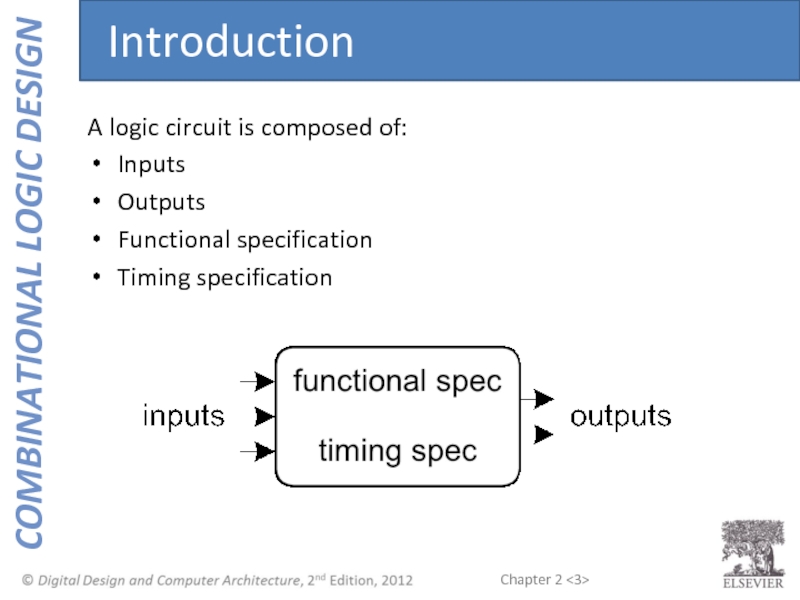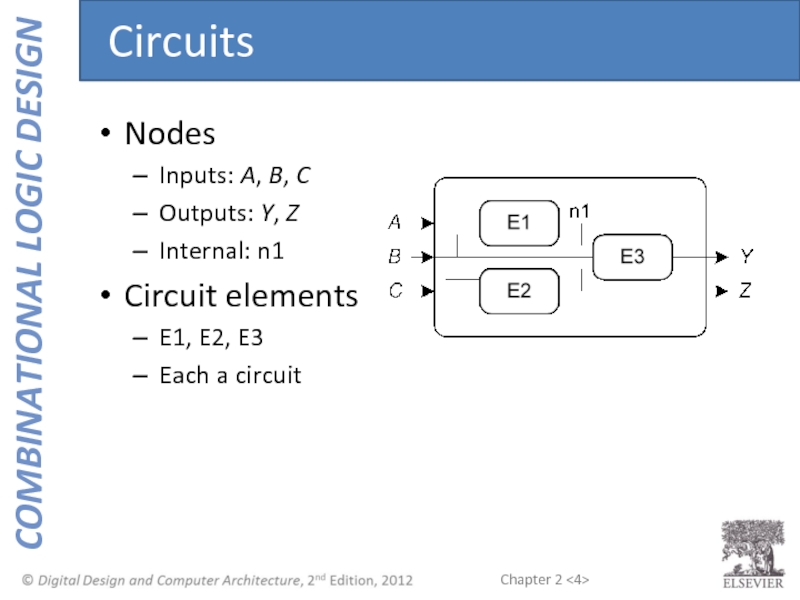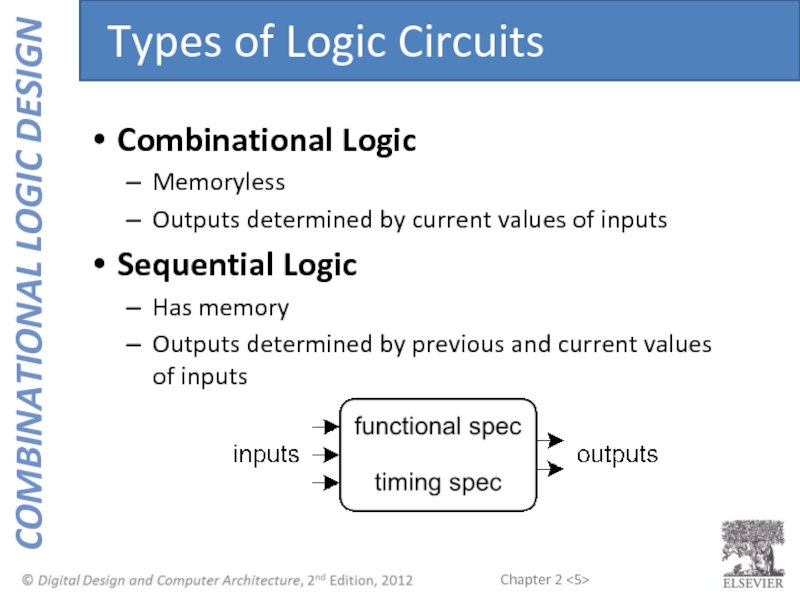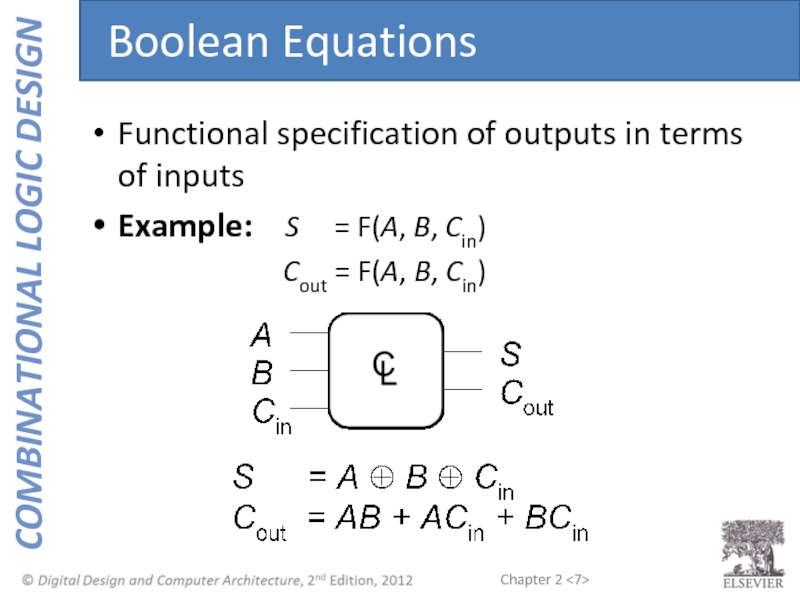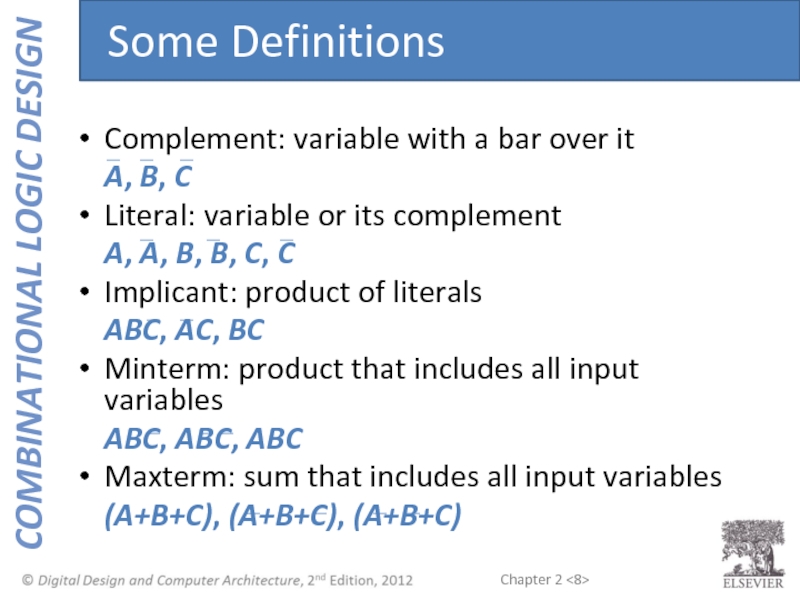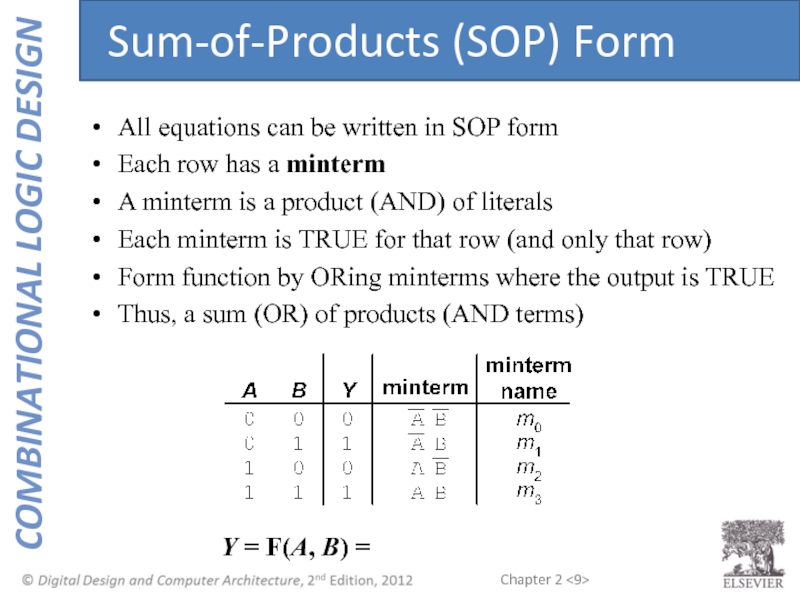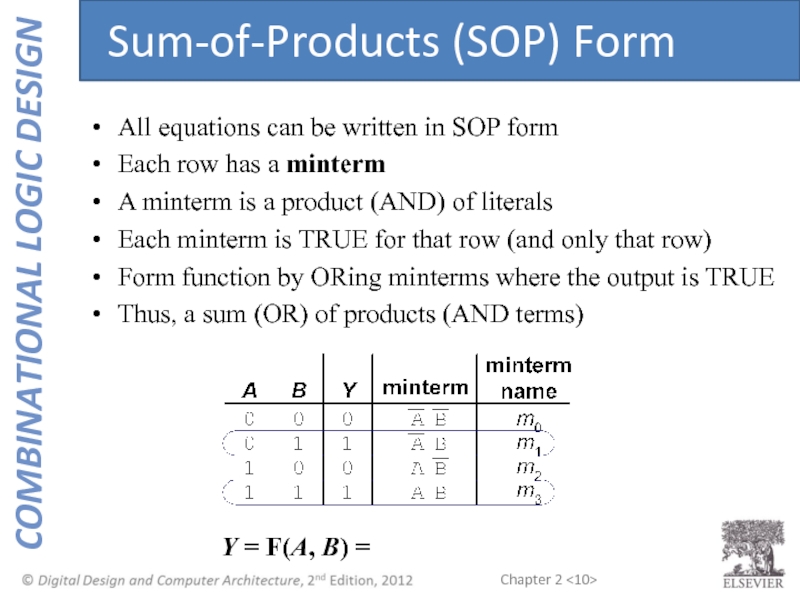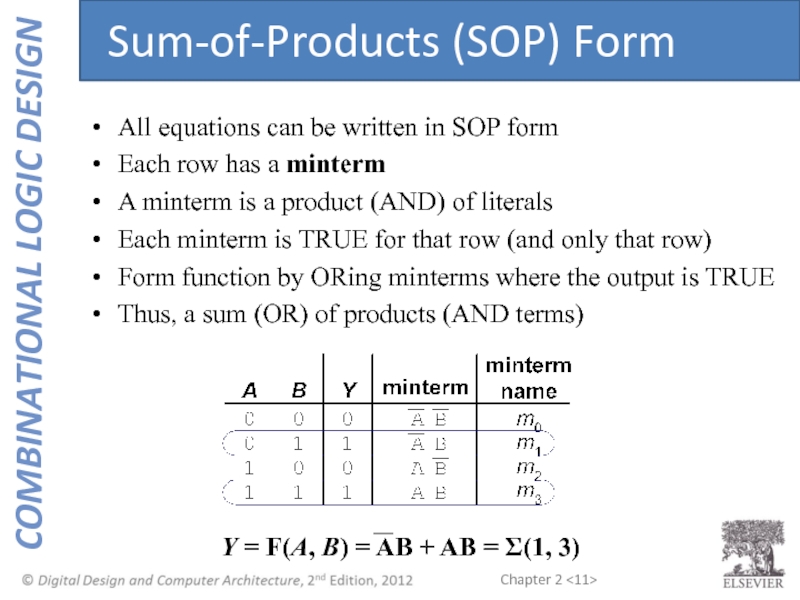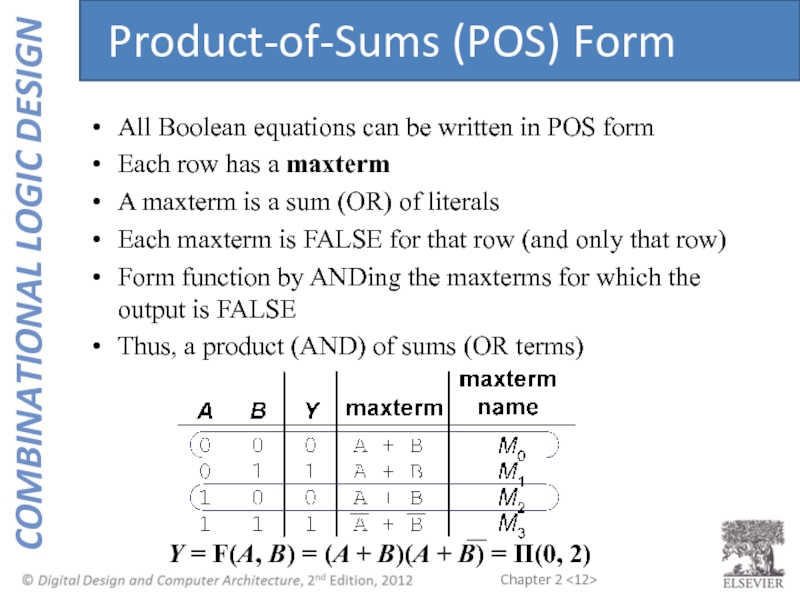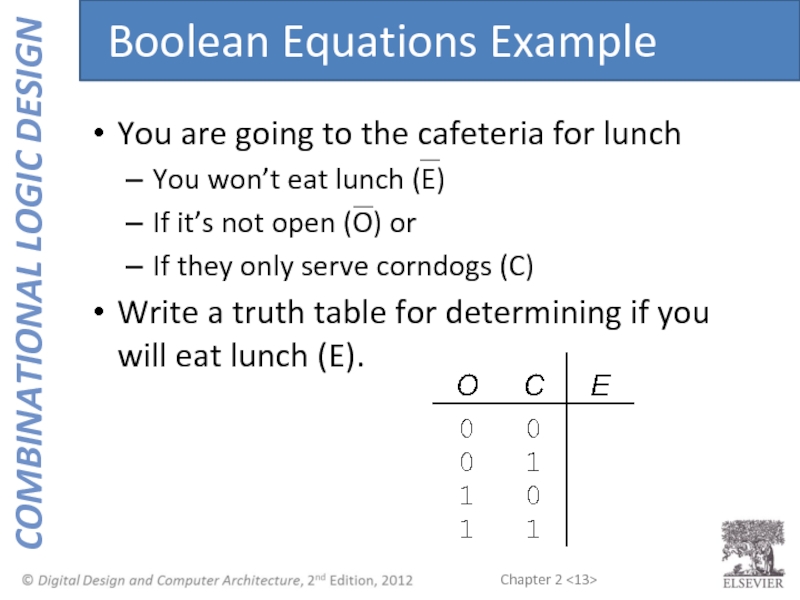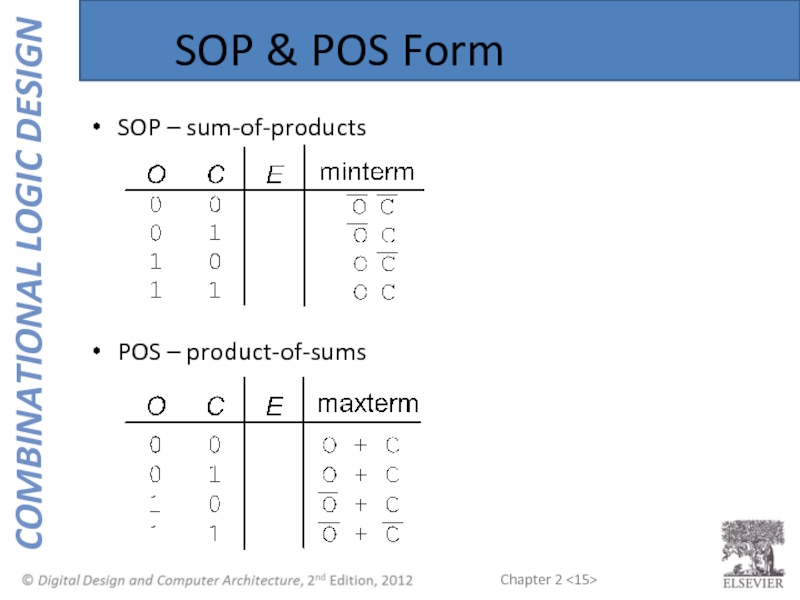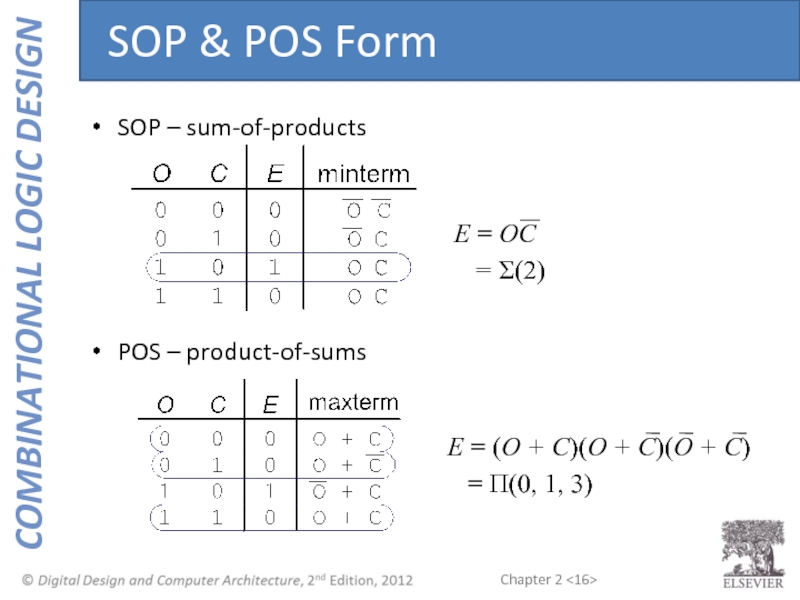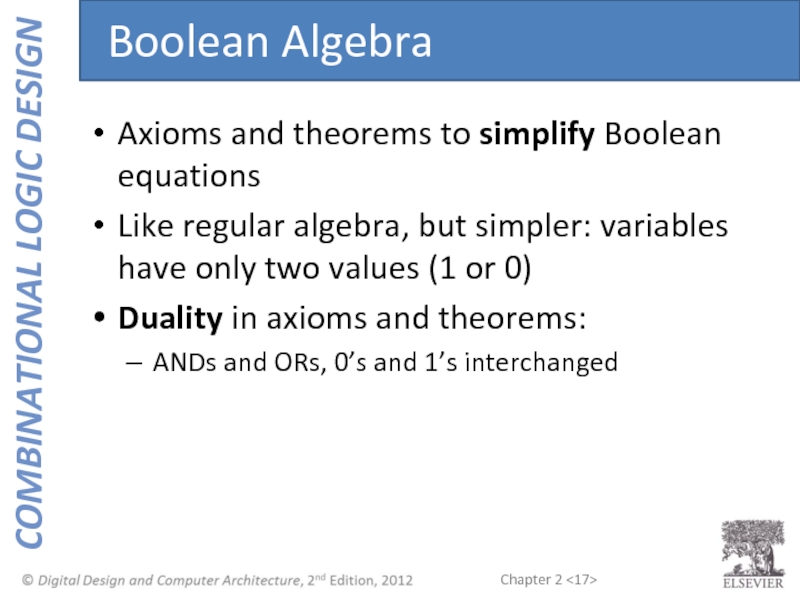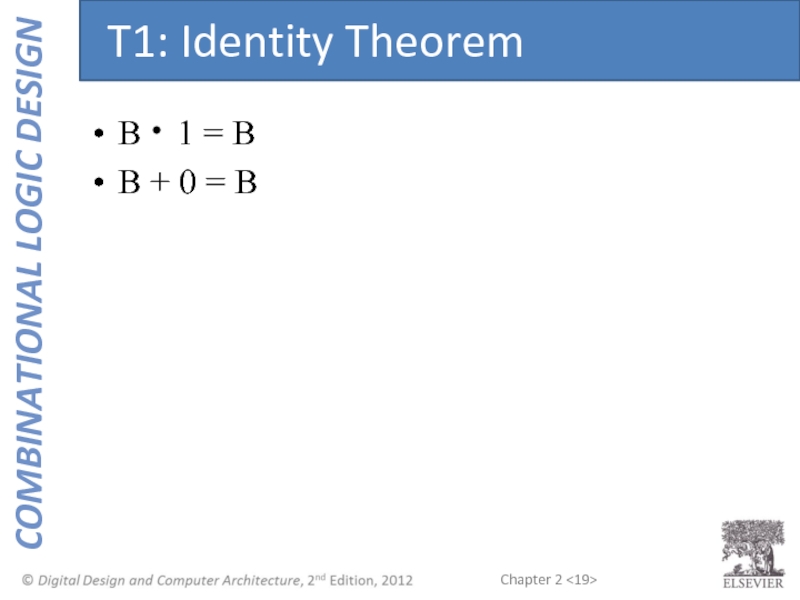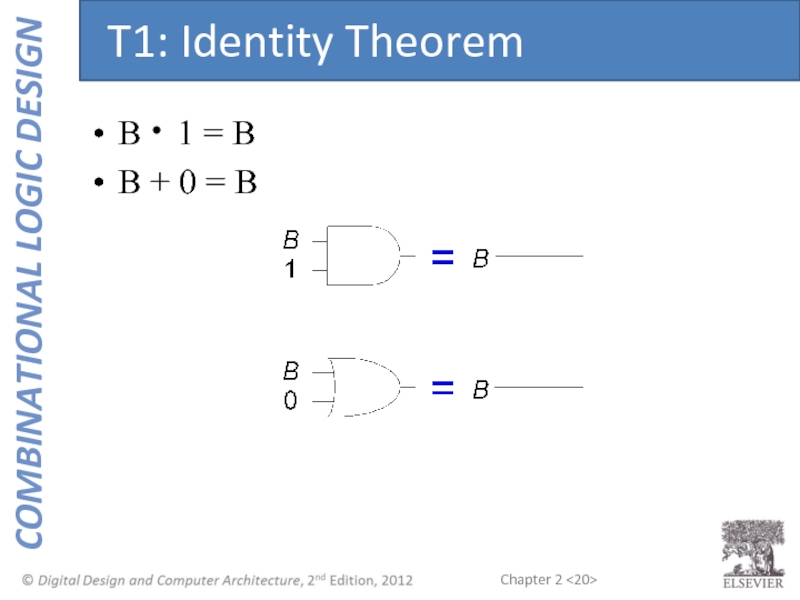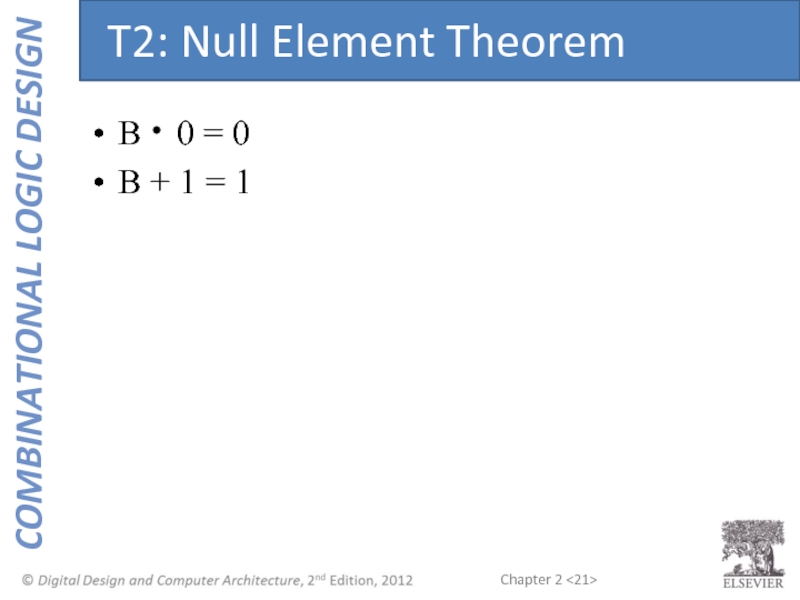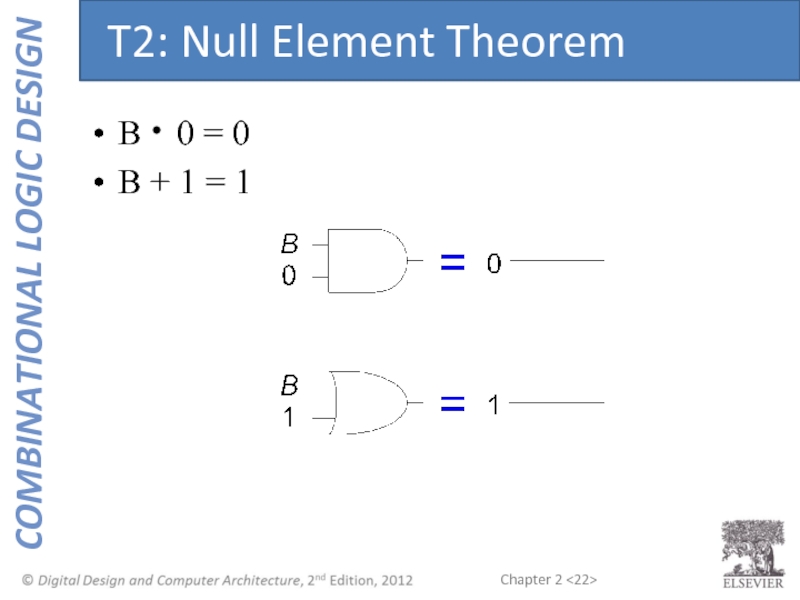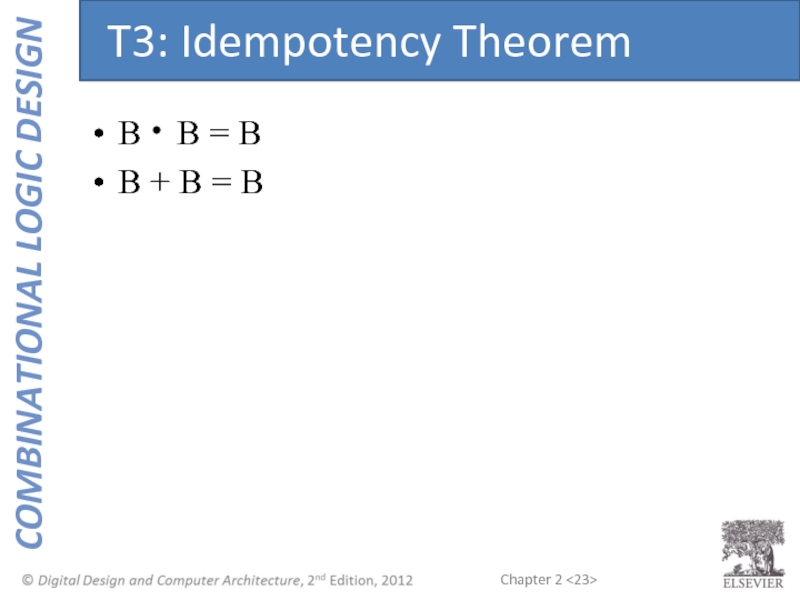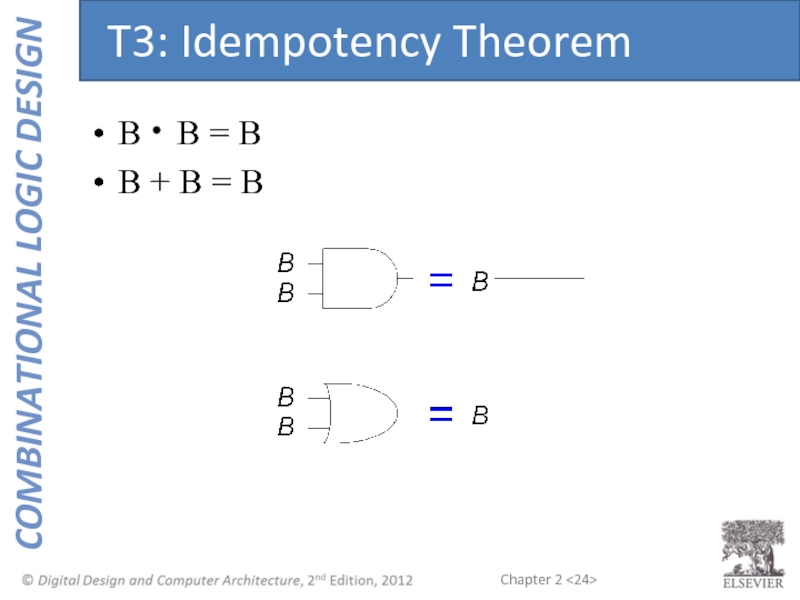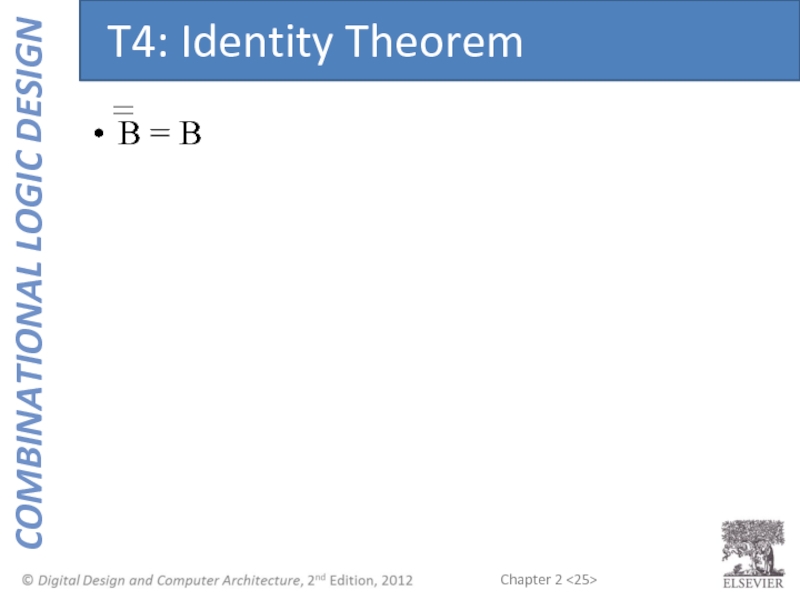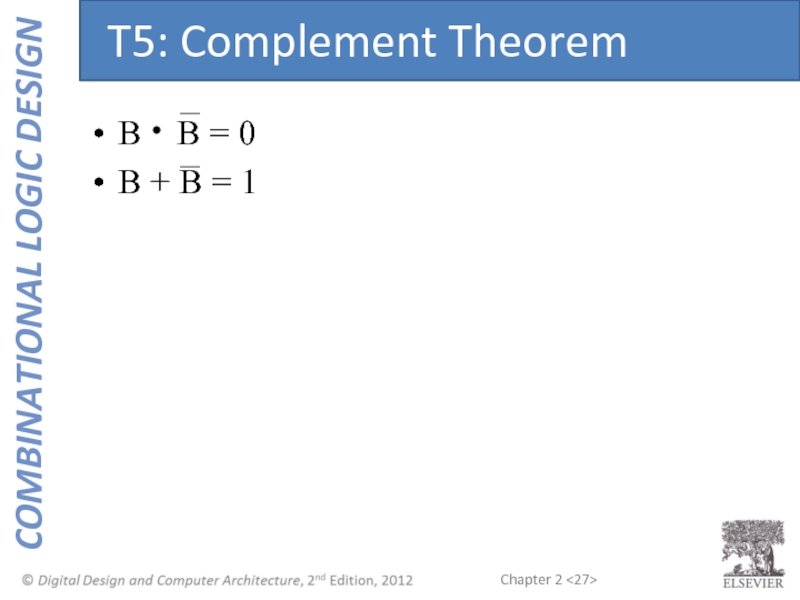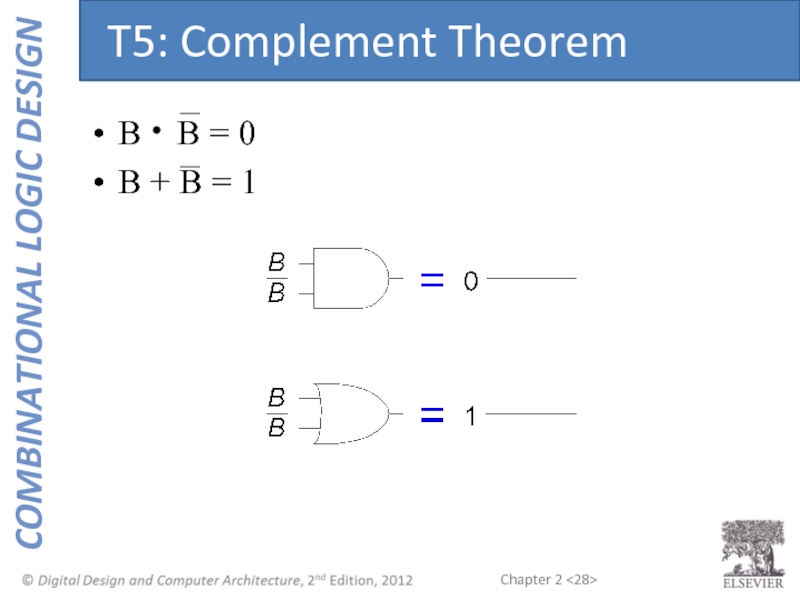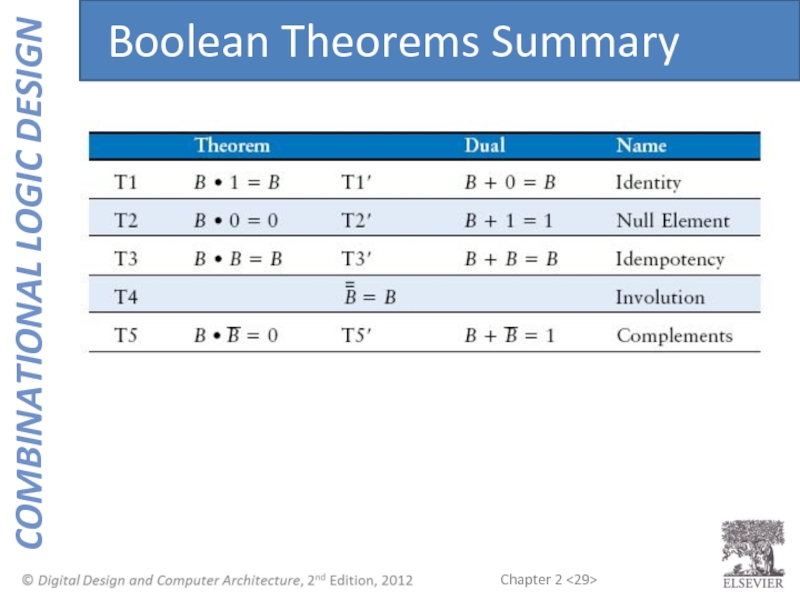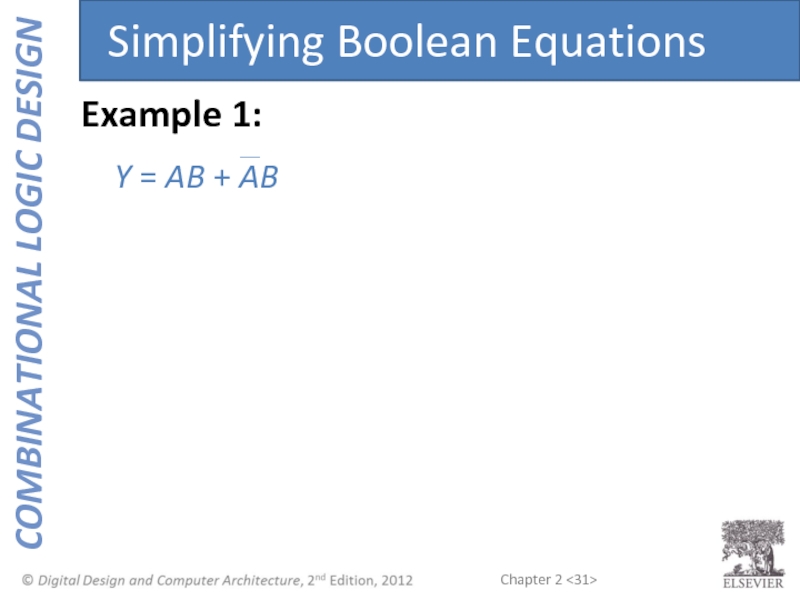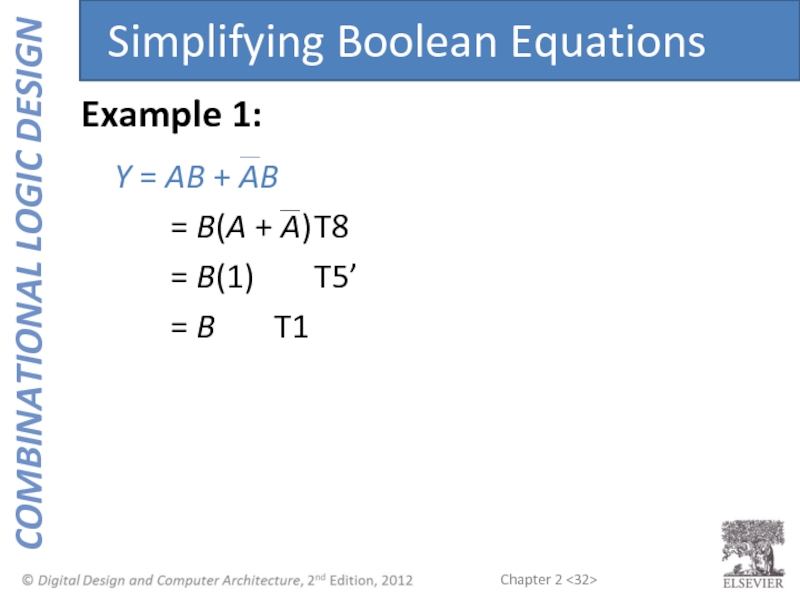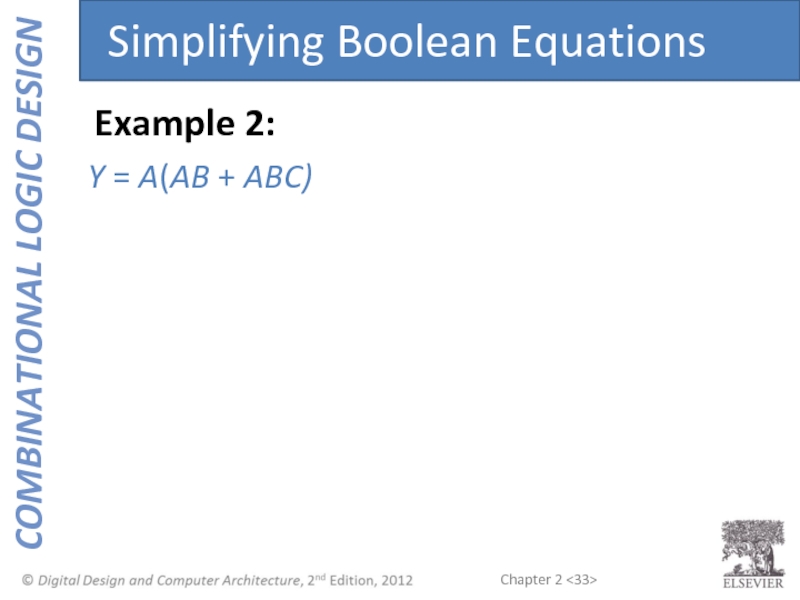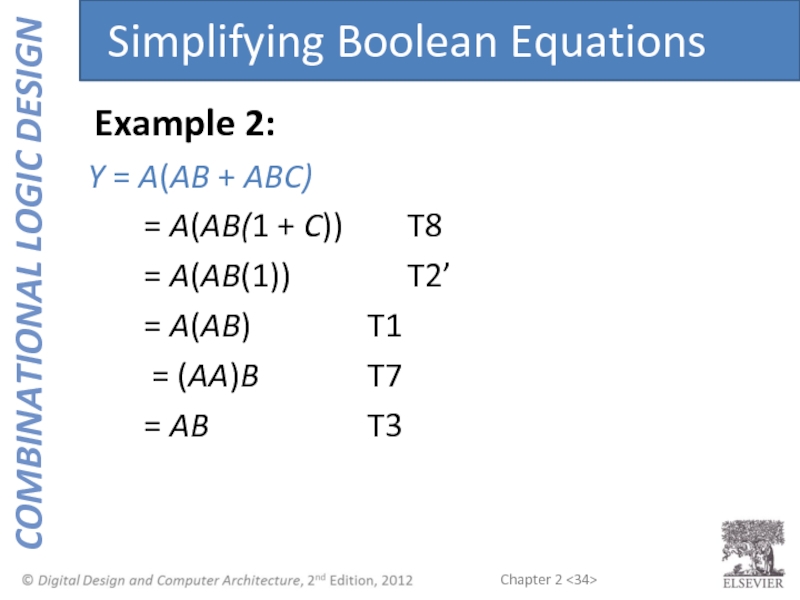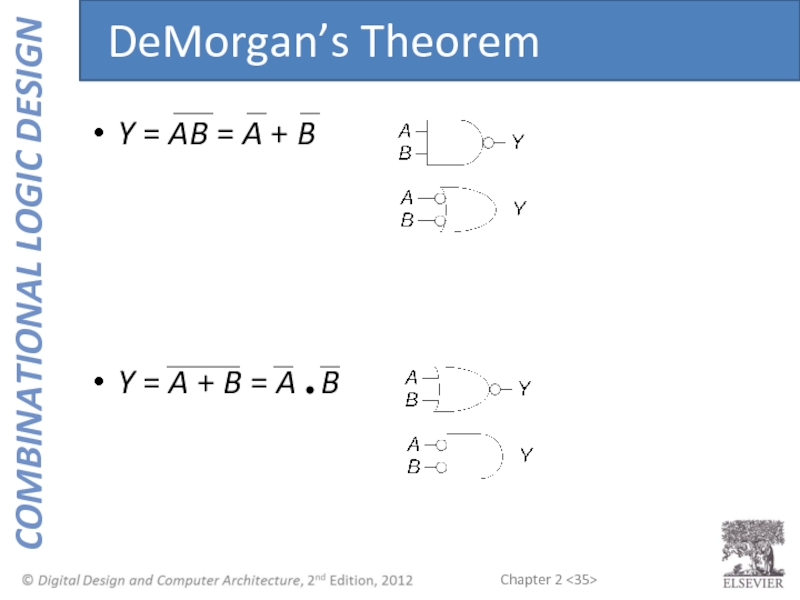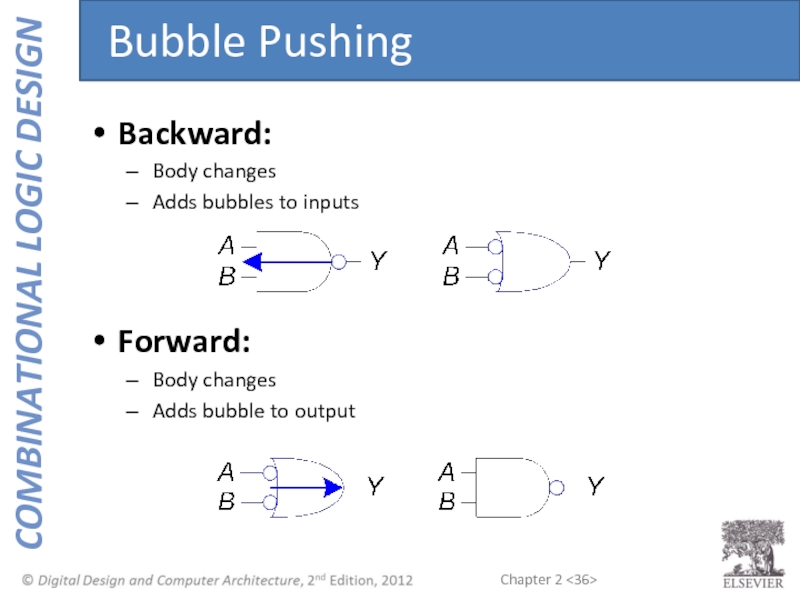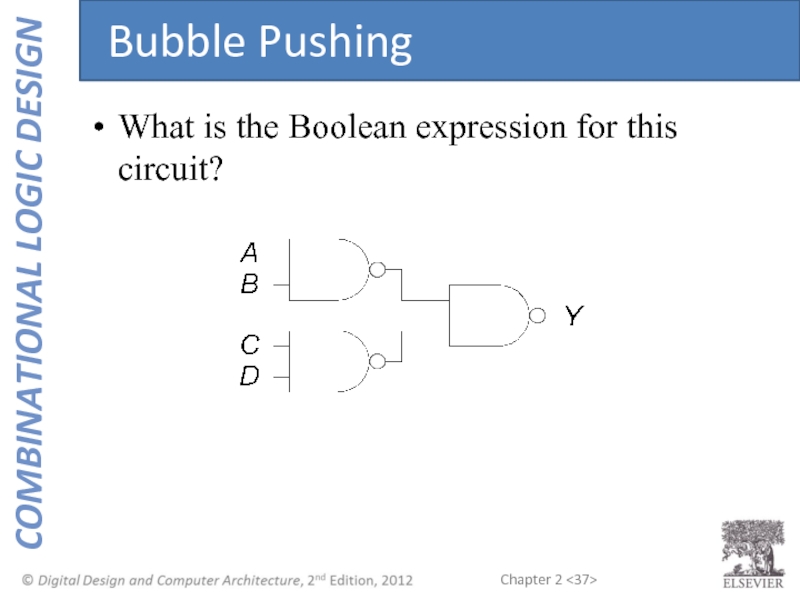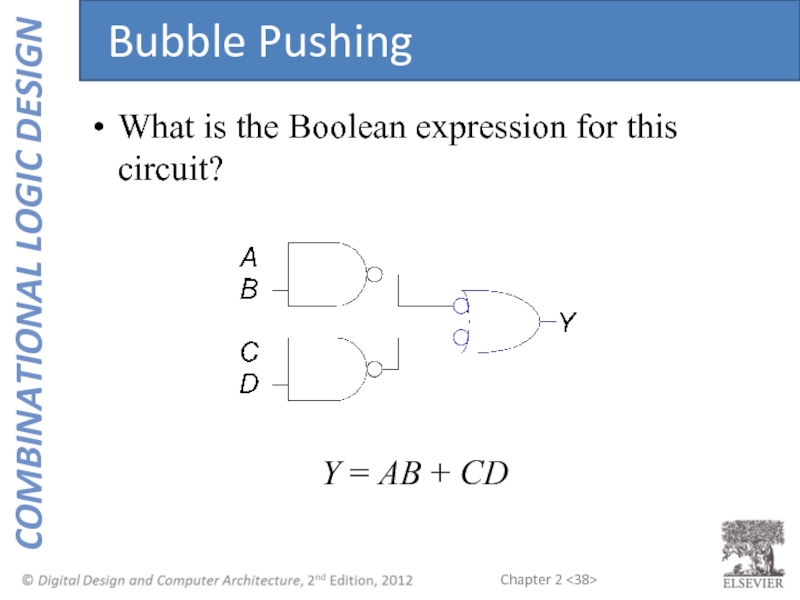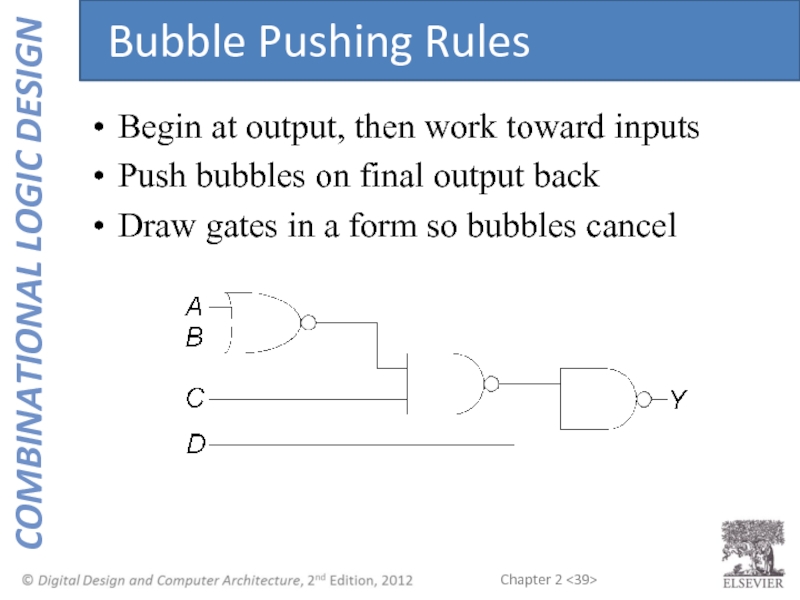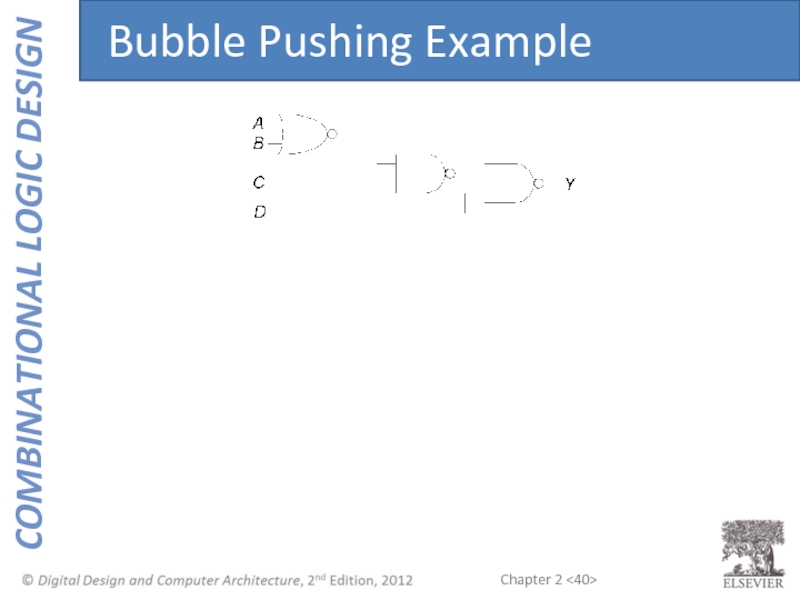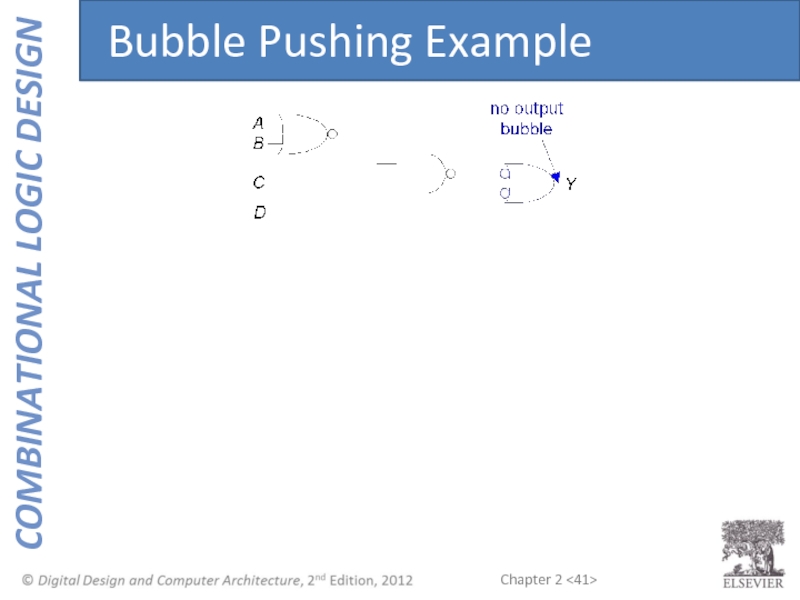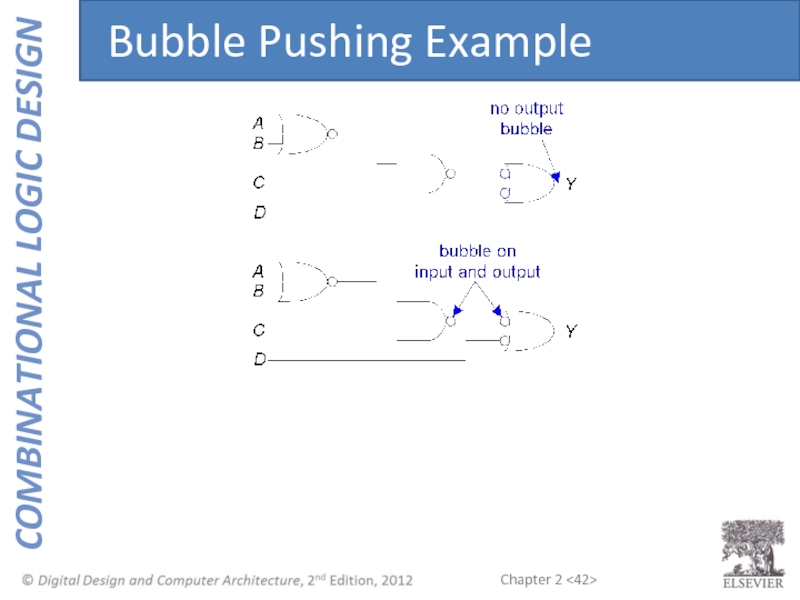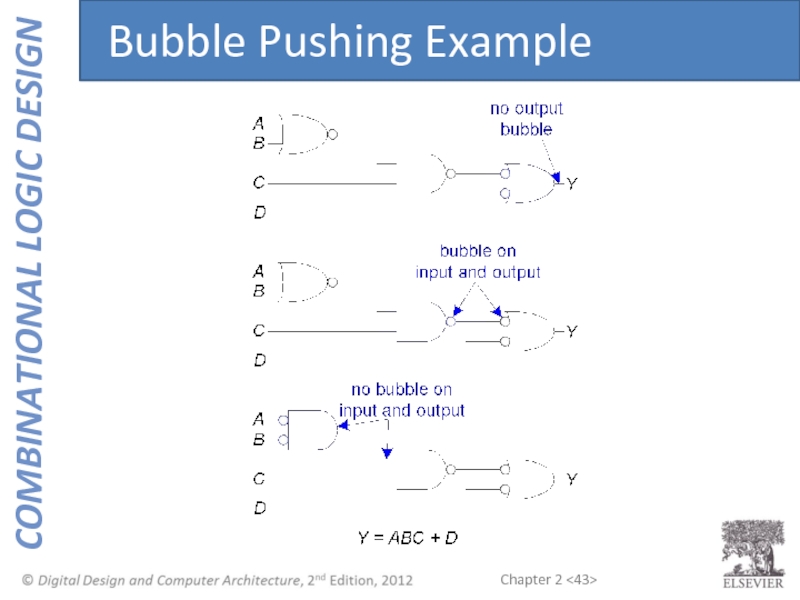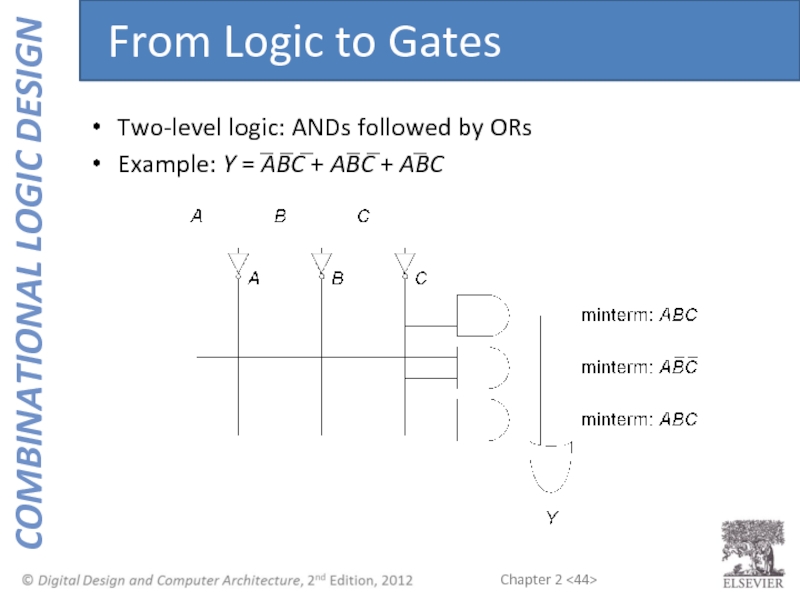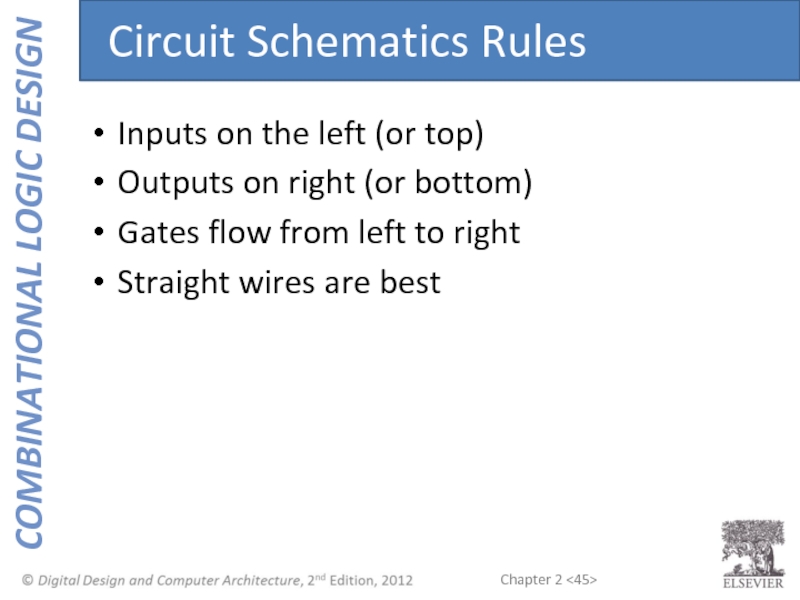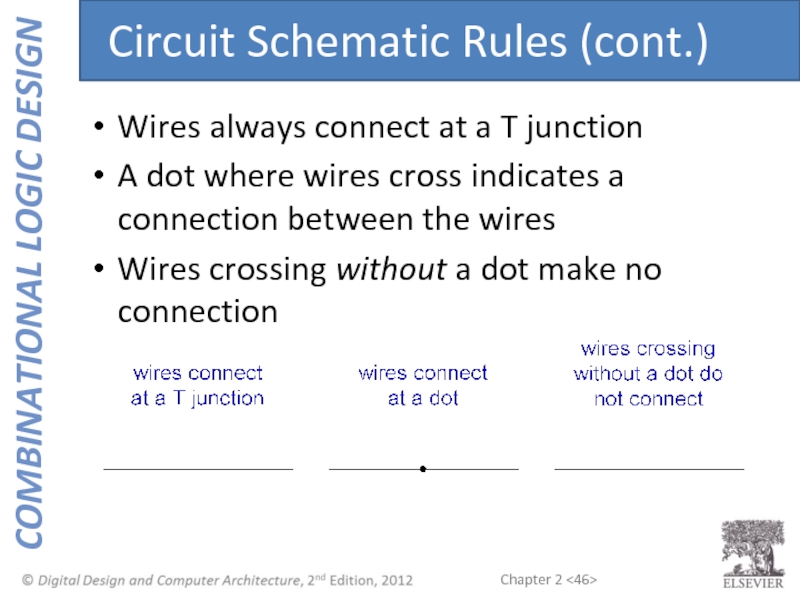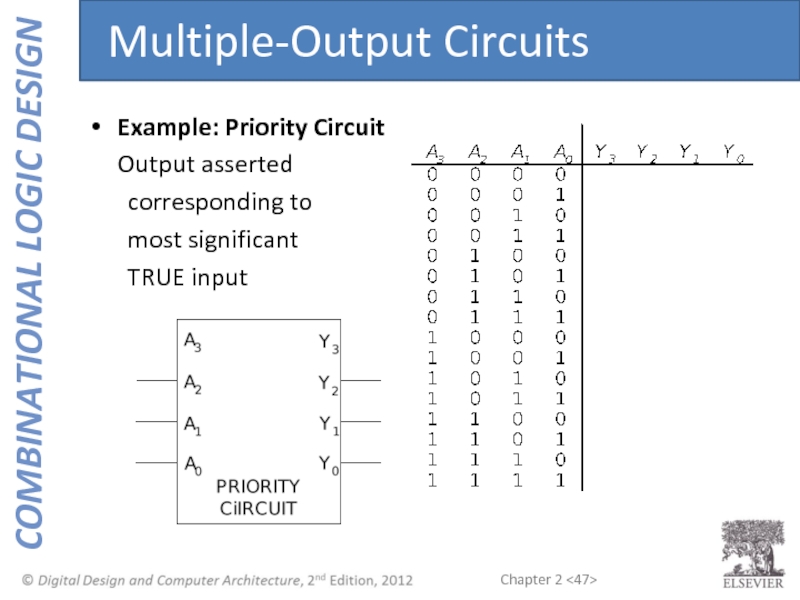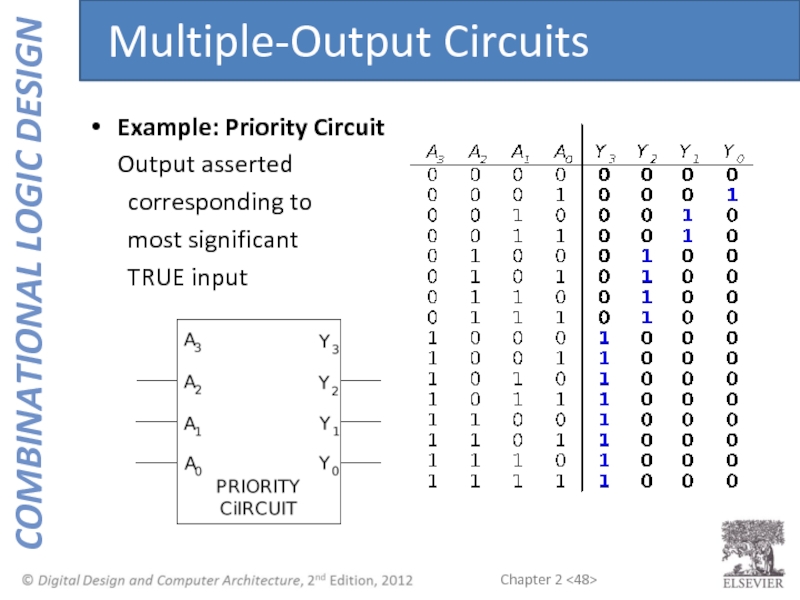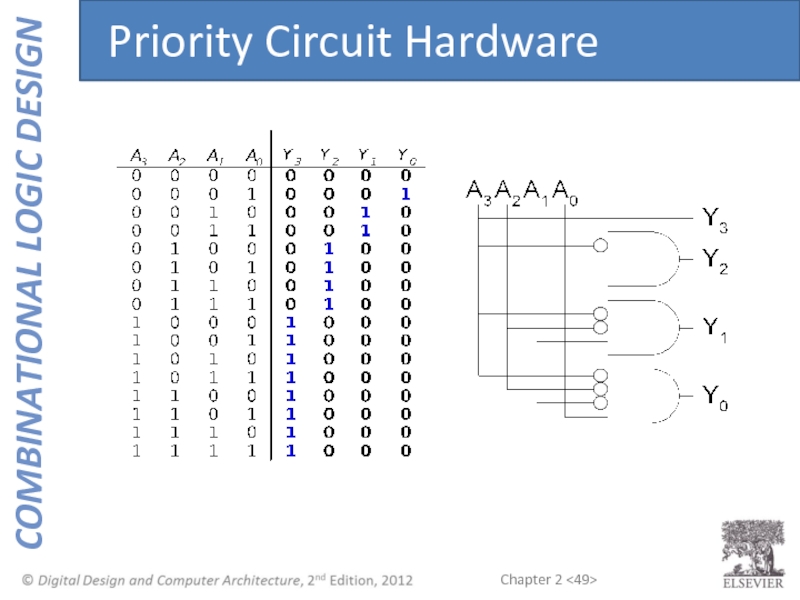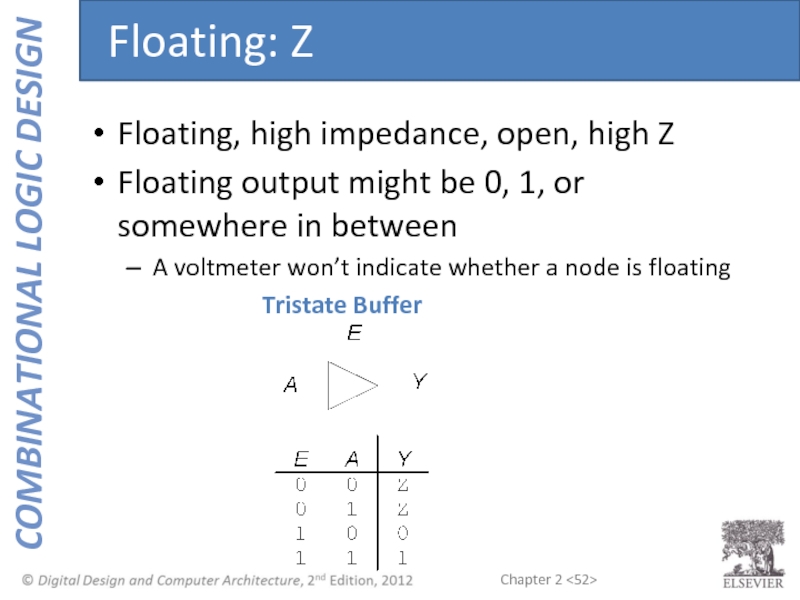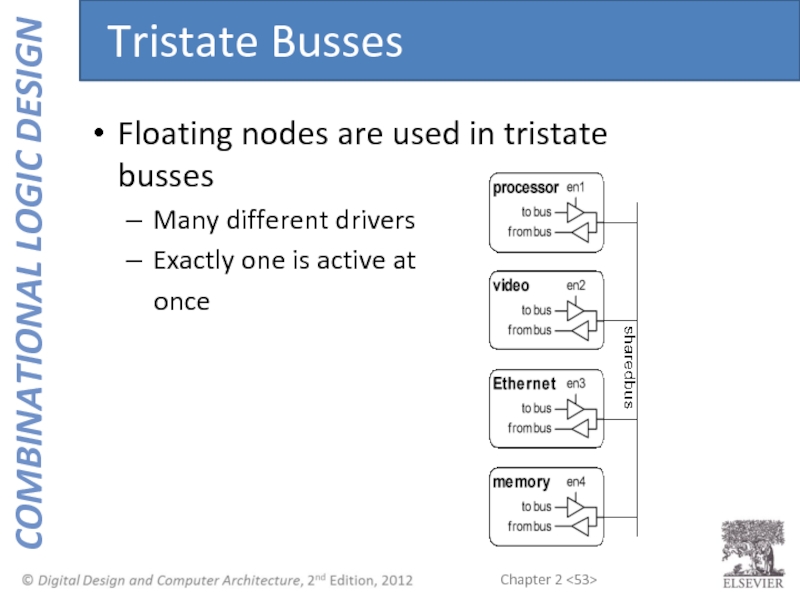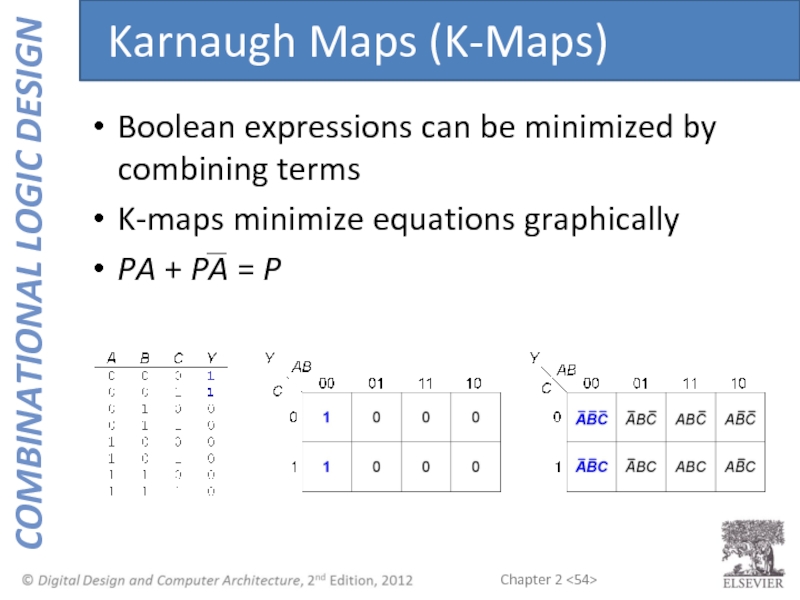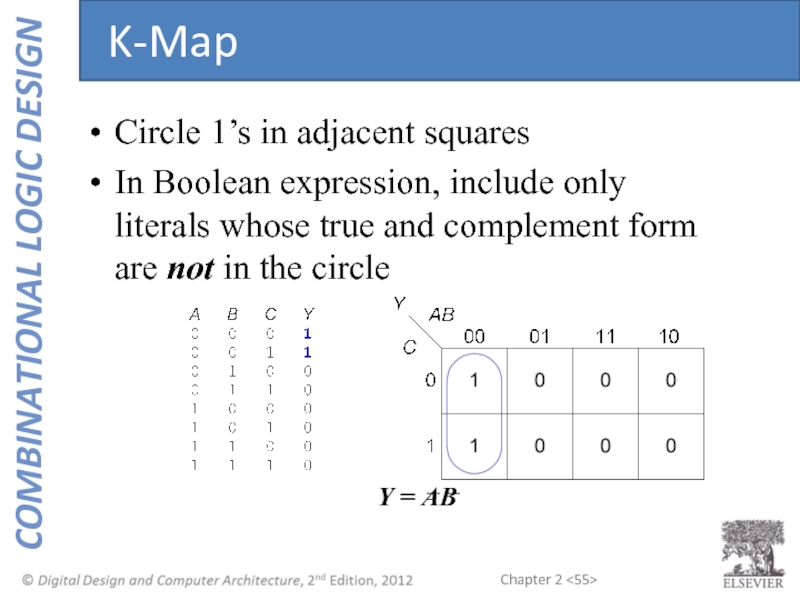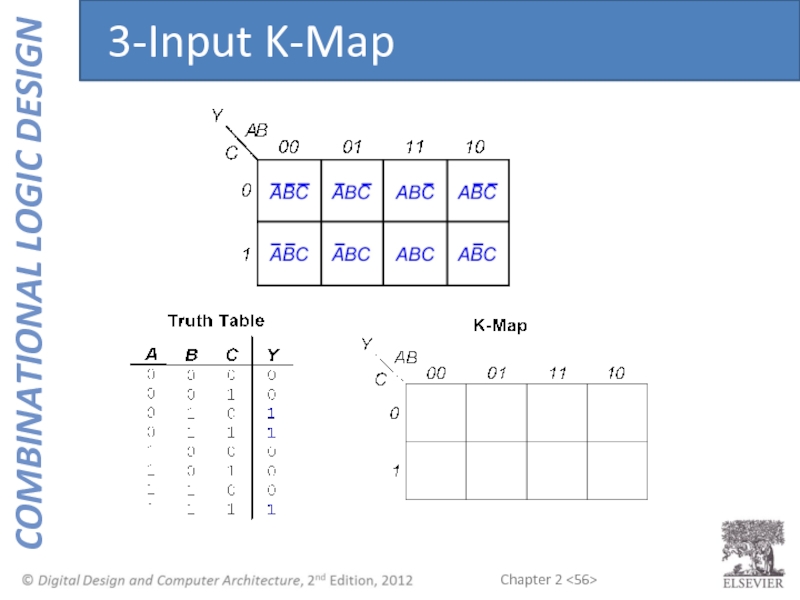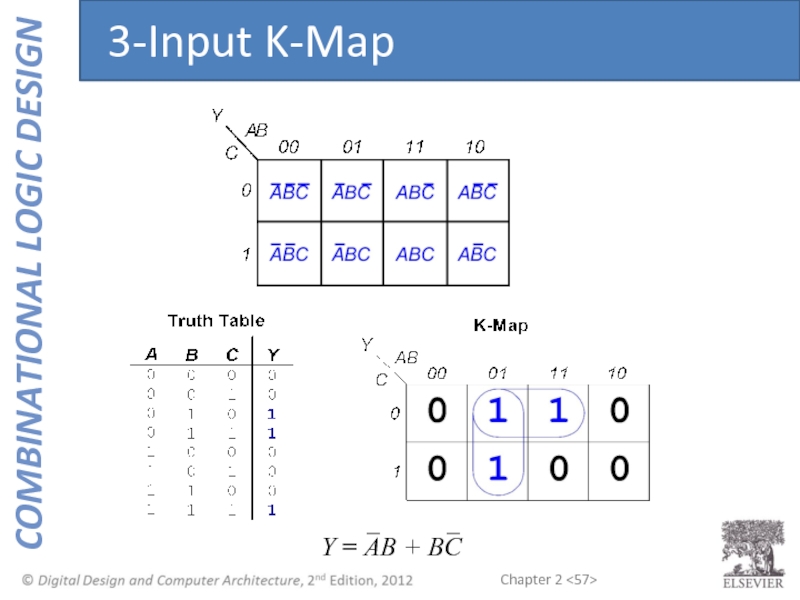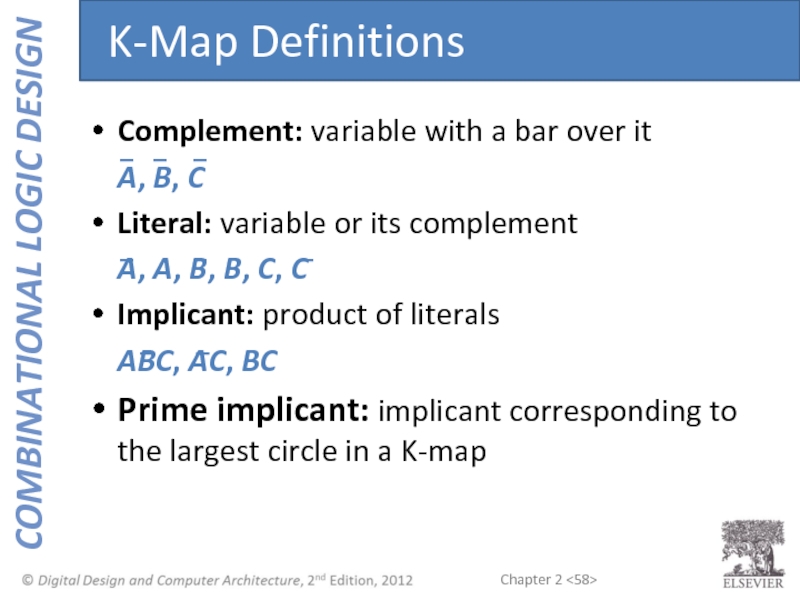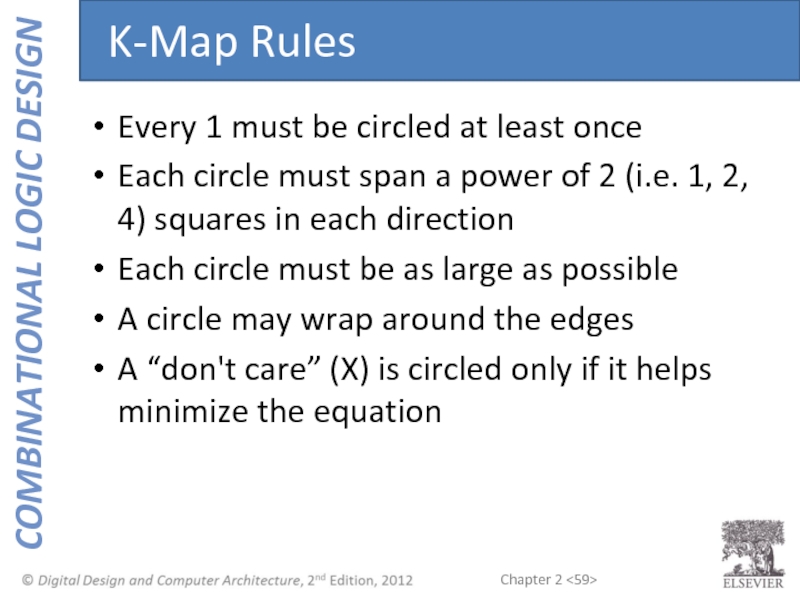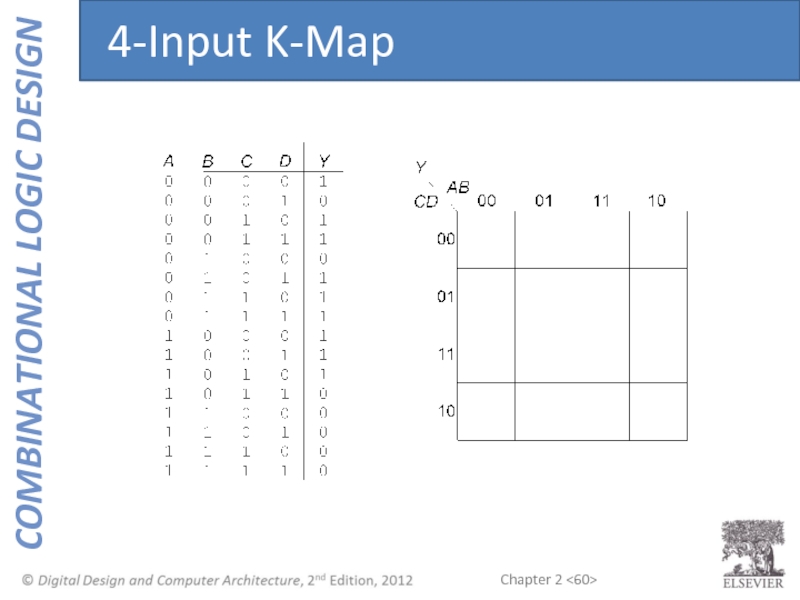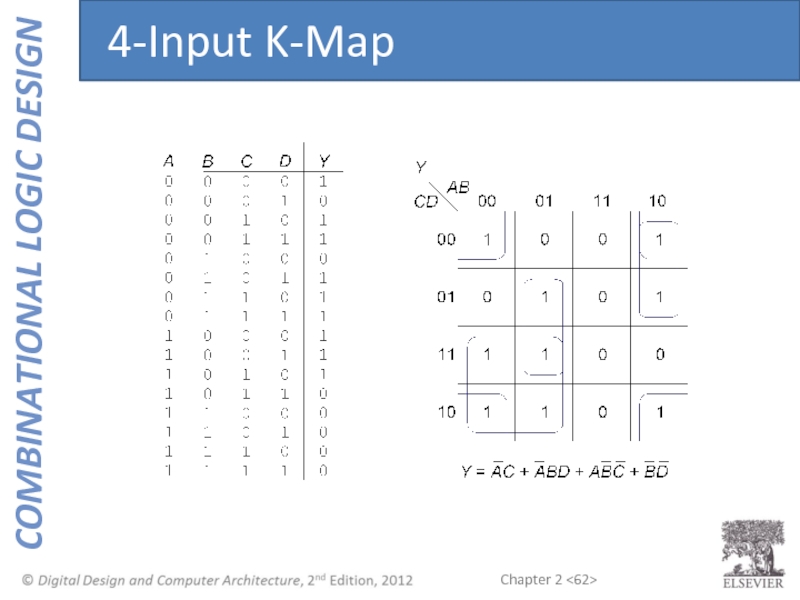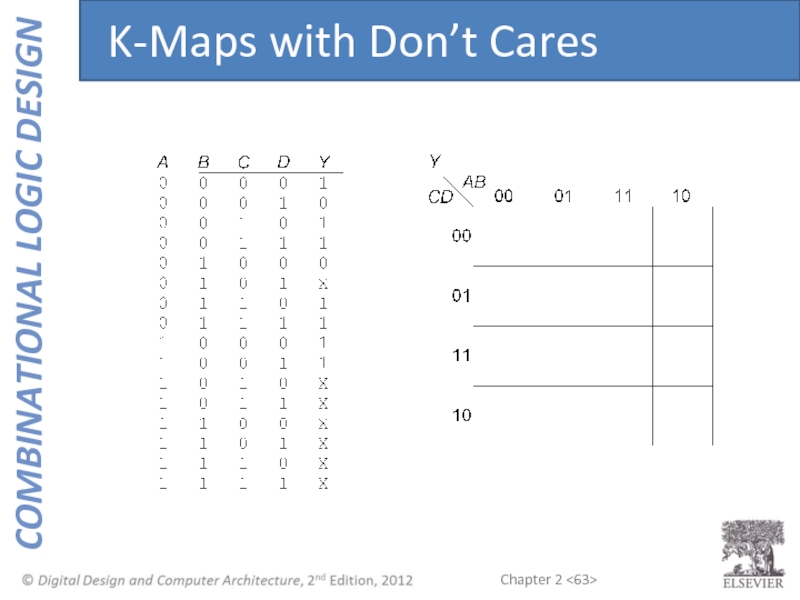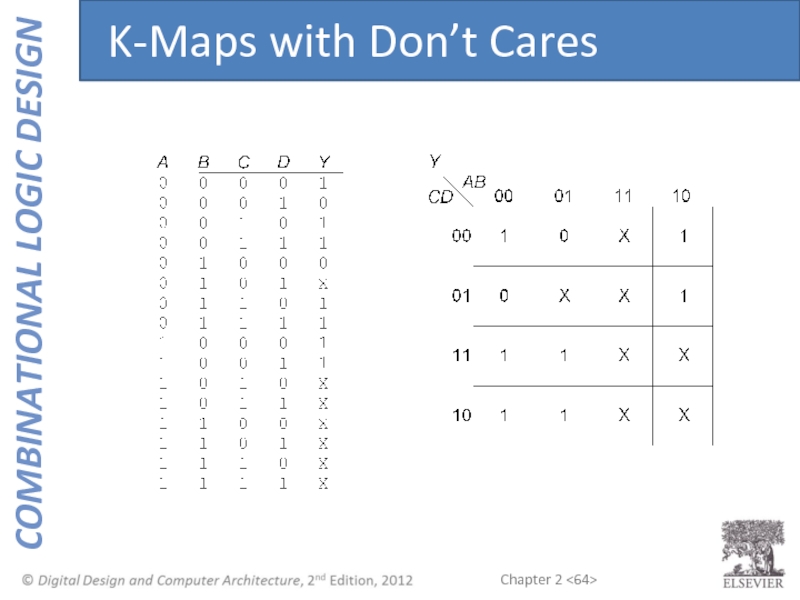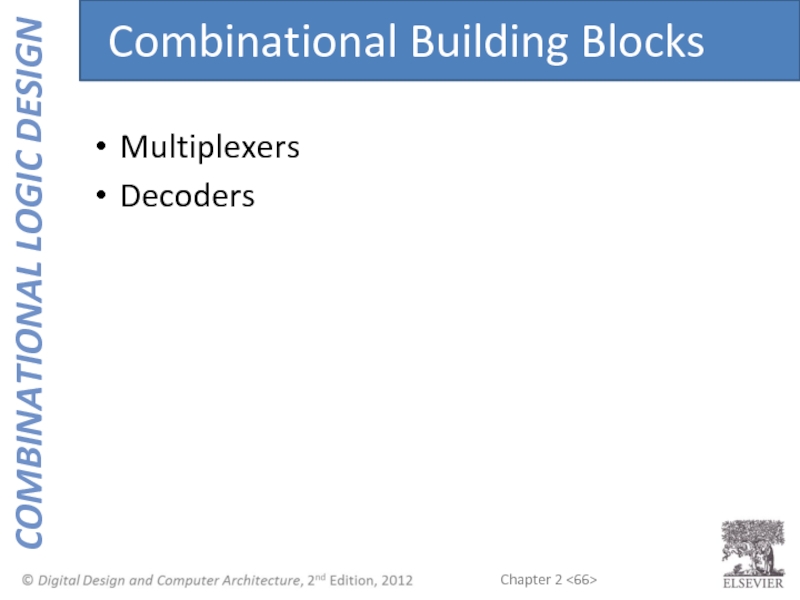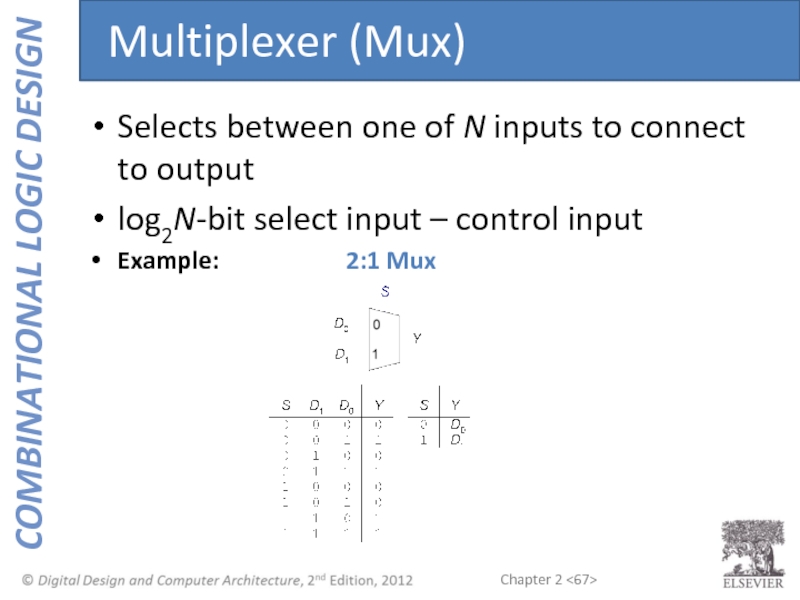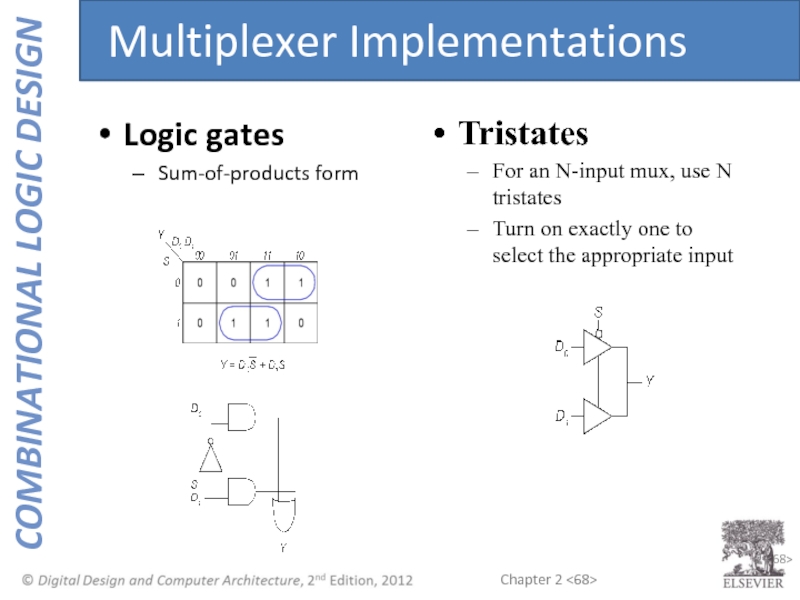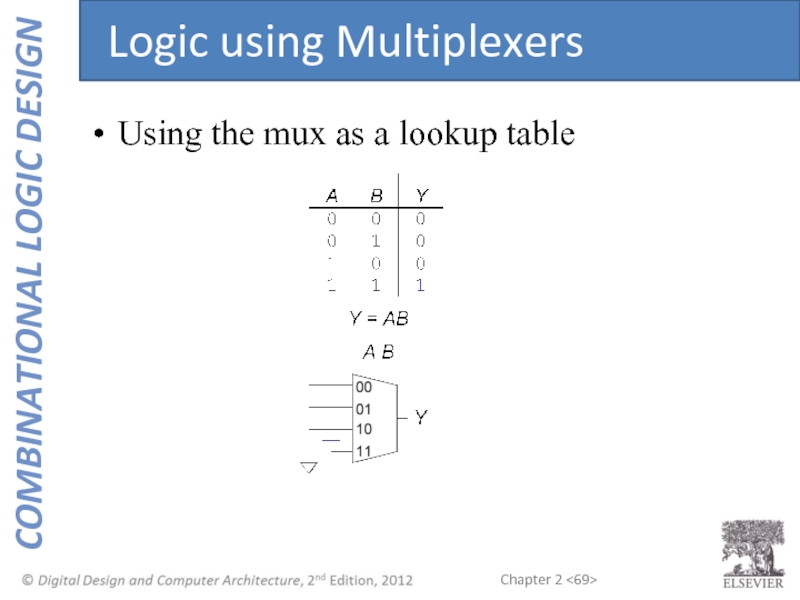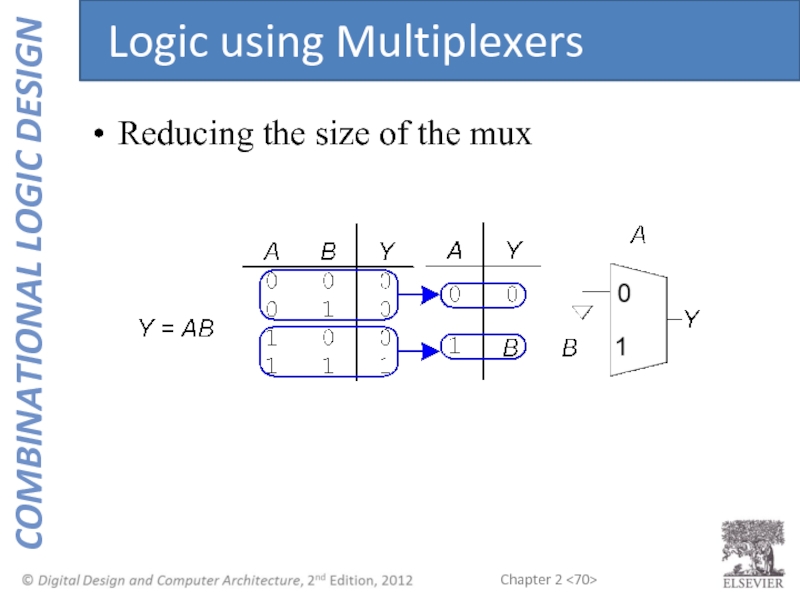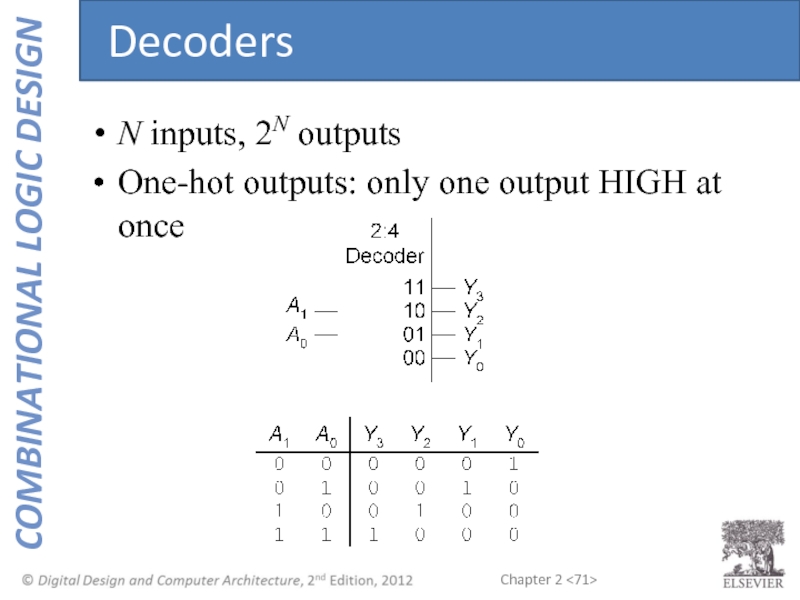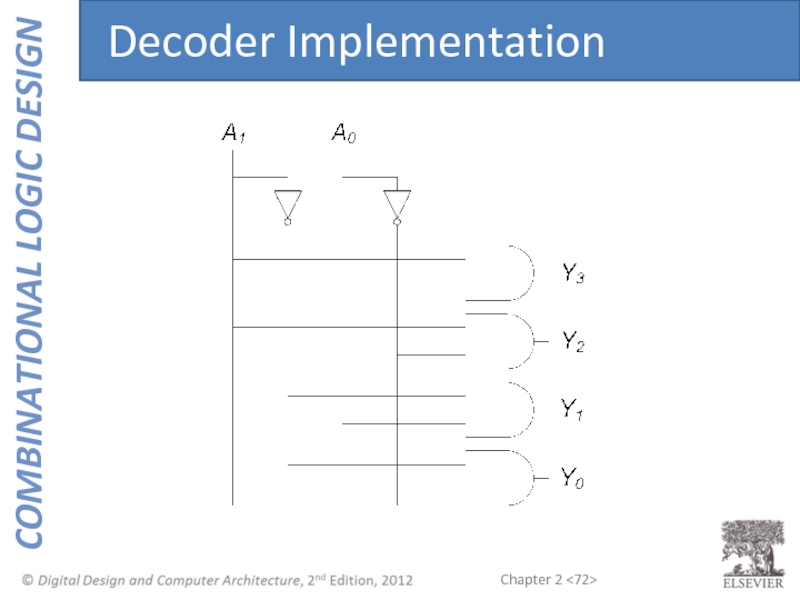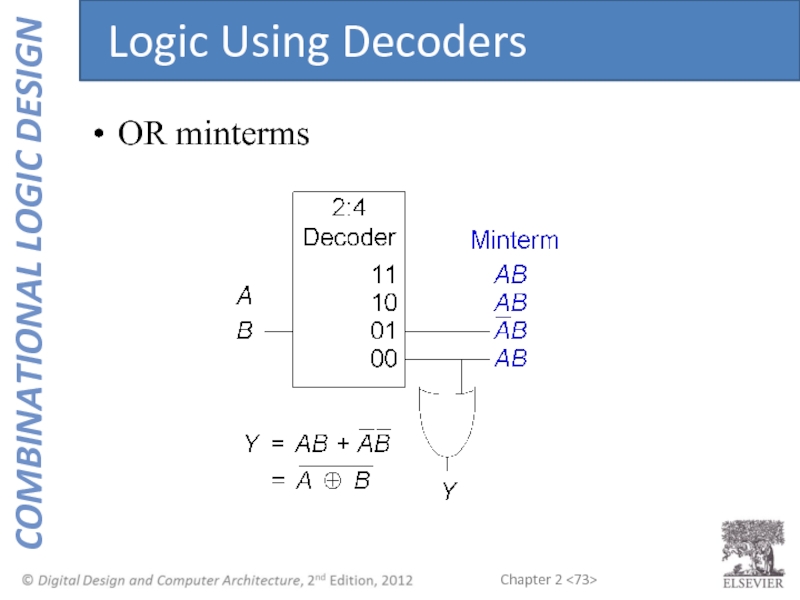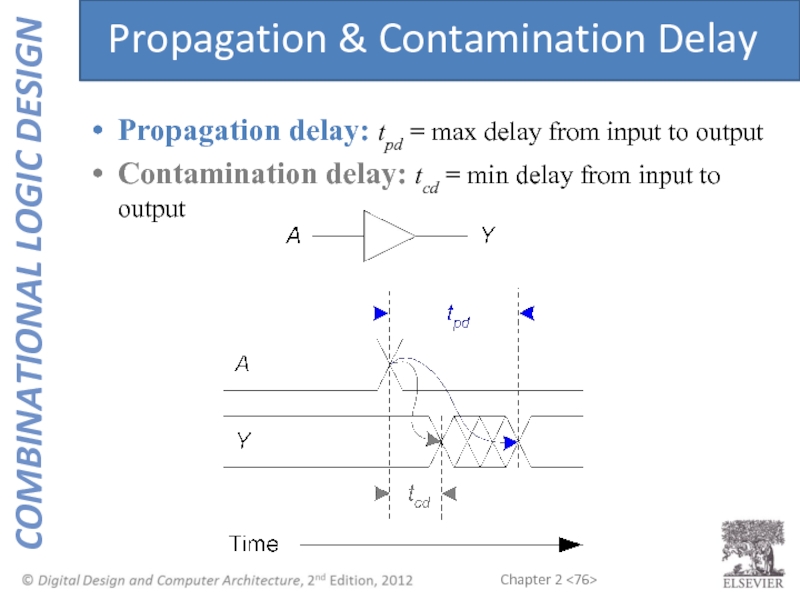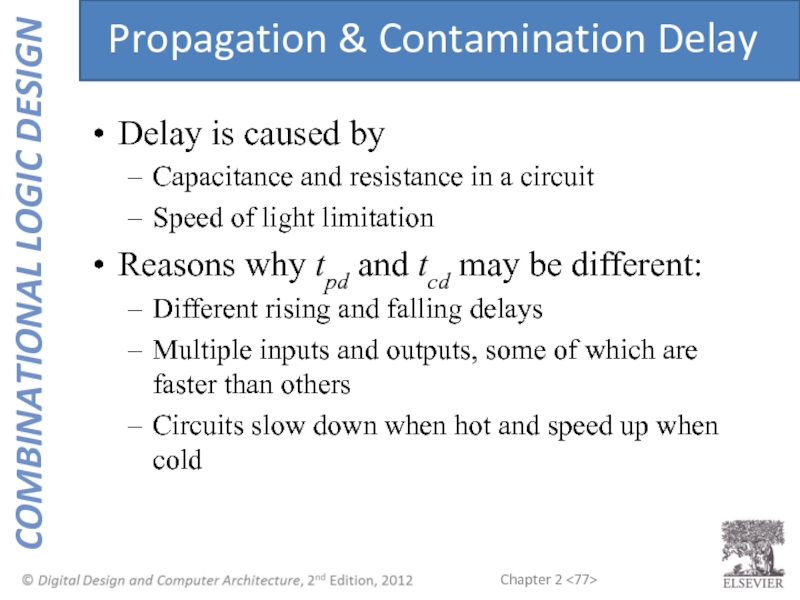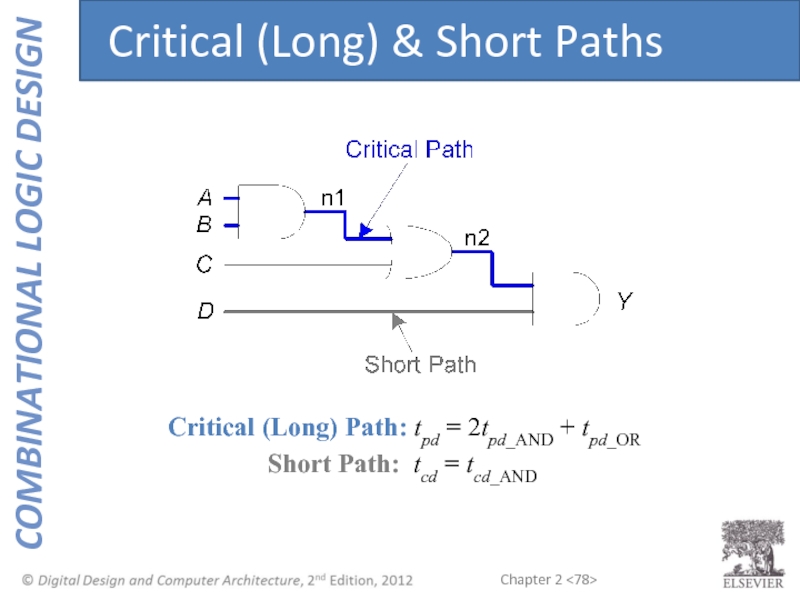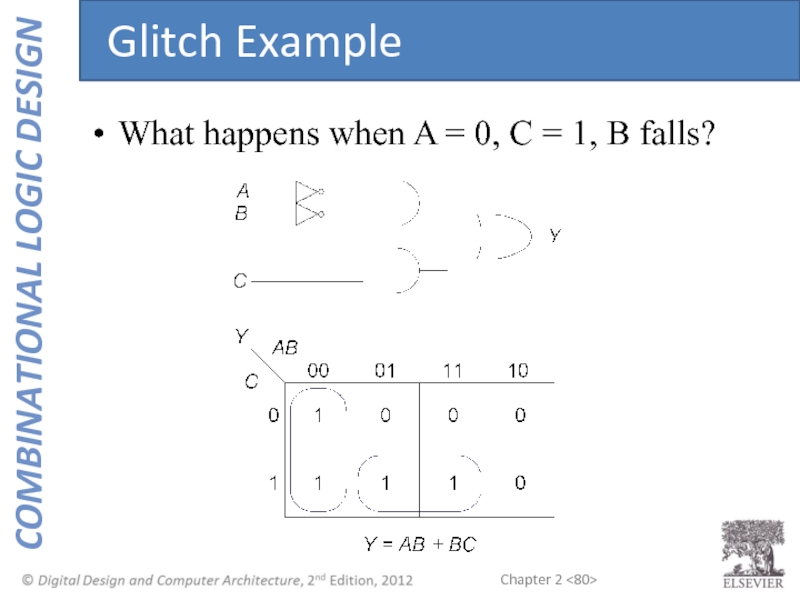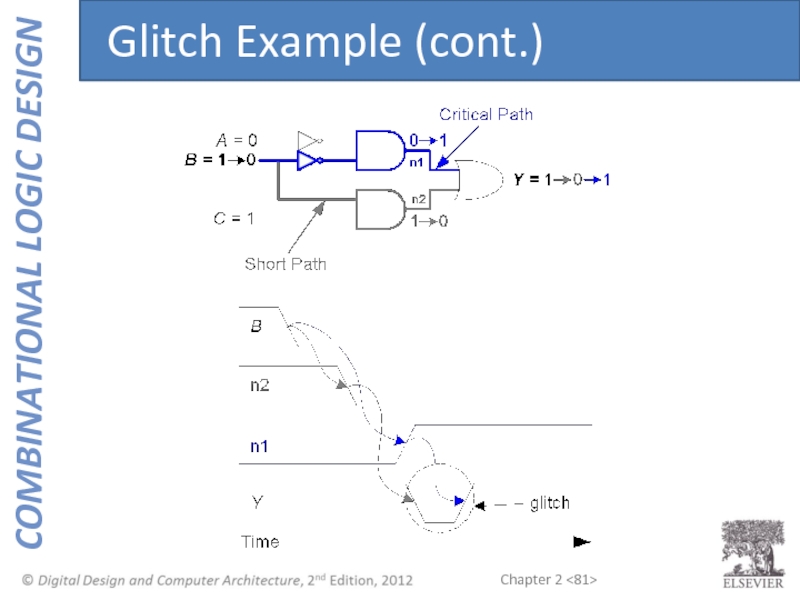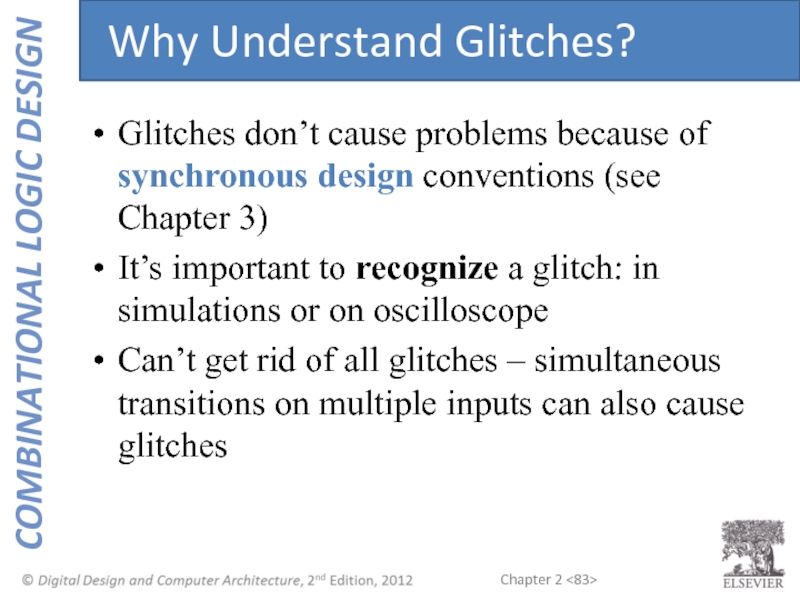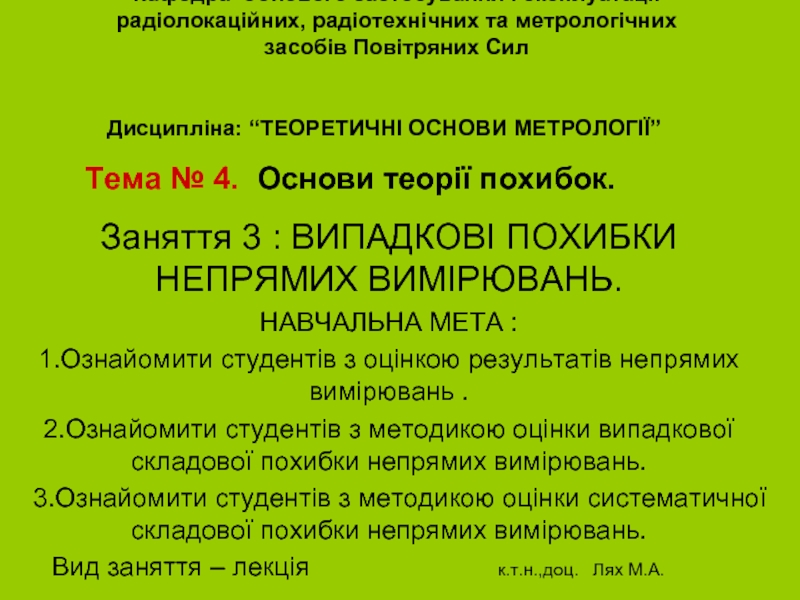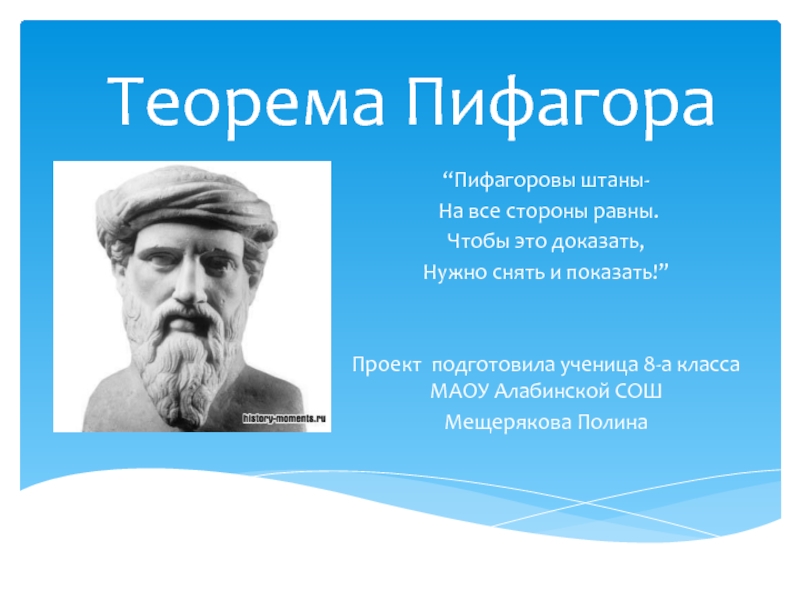- Главная
- Разное
- Дизайн
- Бизнес и предпринимательство
- Аналитика
- Образование
- Развлечения
- Красота и здоровье
- Финансы
- Государство
- Путешествия
- Спорт
- Недвижимость
- Армия
- Графика
- Культурология
- Еда и кулинария
- Лингвистика
- Английский язык
- Астрономия
- Алгебра
- Биология
- География
- Детские презентации
- Информатика
- История
- Литература
- Маркетинг
- Математика
- Медицина
- Менеджмент
- Музыка
- МХК
- Немецкий язык
- ОБЖ
- Обществознание
- Окружающий мир
- Педагогика
- Русский язык
- Технология
- Физика
- Философия
- Химия
- Шаблоны, картинки для презентаций
- Экология
- Экономика
- Юриспруденция
Combinational logic design презентация
Содержание
- 1. Combinational logic design
- 2. Introduction Boolean Equations Boolean Algebra From Logic
- 3. A logic circuit is composed of: Inputs Outputs Functional specification Timing specification Introduction
- 4. Nodes Inputs: A, B, C Outputs: Y,
- 5. Combinational Logic Memoryless Outputs determined by current
- 6. Every element is combinational Every node is
- 7. Functional specification of outputs in terms of
- 8. Complement: variable with a bar over it
- 9. Y = F(A, B) = All equations
- 10. Y = F(A, B) = Sum-of-Products (SOP)
- 11. Y = F(A, B) = AB +
- 12. Y = F(A, B) = (A +
- 13. You are going to the cafeteria for
- 14. You are going to the cafeteria for
- 15. SOP & POS Form SOP – sum-of-products POS – product-of-sums
- 16. SOP – sum-of-products
- 17. Axioms and theorems to simplify Boolean equations
- 18. Boolean Axioms
- 19. B 1 = B B + 0 = B T1: Identity Theorem
- 20. B 1 = B B + 0 = B T1: Identity Theorem
- 21. B 0 = 0 B + 1 = 1 T2: Null Element Theorem
- 22. B 0 = 0 B + 1 = 1 T2: Null Element Theorem
- 23. B B = B B + B = B T3: Idempotency Theorem
- 24. B B = B B + B = B T3: Idempotency Theorem
- 25. B = B T4: Identity Theorem
- 26. B = B T4: Identity Theorem
- 27. B B = 0 B + B = 1 T5: Complement Theorem
- 28. B B = 0 B + B = 1 T5: Complement Theorem
- 29. Boolean Theorems Summary
- 30. Boolean Theorems of Several Vars Note: T8’
- 31. Y = AB + AB Simplifying Boolean Equations Example 1:
- 32. Y = AB + AB
- 33. Y = A(AB + ABC) Example 2: Simplifying Boolean Equations
- 34. Y = A(AB + ABC)
- 35. Y = AB = A + B
- 36. Backward: Body changes Adds bubbles to inputs
- 37. What is the Boolean expression for this circuit? Bubble Pushing
- 38. What is the Boolean expression for this
- 39. Begin at output, then work toward inputs
- 40. Bubble Pushing Example
- 41. Bubble Pushing Example
- 42. Bubble Pushing Example
- 43. Bubble Pushing Example
- 44. Two-level logic: ANDs followed by ORs Example:
- 45. Inputs on the left (or top) Outputs
- 46. Wires always connect at a T junction
- 47. Example: Priority Circuit Output
- 48. Example: Priority Circuit Output
- 49. Priority Circuit Hardware
- 50. Don’t Cares
- 51. Contention: circuit tries to drive output to
- 52. Floating, high impedance, open, high Z Floating
- 53. Floating nodes are used in tristate busses
- 54. Boolean expressions can be minimized by combining
- 55. Circle 1’s in adjacent squares In Boolean
- 56. 3-Input K-Map
- 57. Y = AB + BC 3-Input K-Map
- 58. Complement: variable with a bar over it
- 59. Every 1 must be circled at least
- 60. 4-Input K-Map
- 61. 4-Input K-Map
- 62. 4-Input K-Map
- 63. K-Maps with Don’t Cares
- 64. K-Maps with Don’t Cares
- 65. K-Maps with Don’t Cares
- 66. Multiplexers Decoders Combinational Building Blocks
- 67. Selects between one of N inputs to
- 68. 2- Logic gates Sum-of-products form Tristates
- 69. Using the mux as a lookup table Logic using Multiplexers
- 70. Reducing the size of the mux Logic using Multiplexers
- 71. N inputs, 2N outputs One-hot outputs: only one output HIGH at once Decoders
- 72. Decoder Implementation
- 73. OR minterms Logic Using Decoders
- 74. ENOUGH FOR TODAY!
- 75. Delay between input change and output changing How to build fast circuits? Timing
- 76. Propagation delay: tpd = max delay from
- 77. Delay is caused by
- 79. When a single input change causes an output to change multiple times Glitches
- 80. What happens when A = 0, C = 1, B falls? Glitch Example
- 81. Glitch Example (cont.)
- 82. Fixing the Glitch
- 83. Glitches don’t cause problems because of
Слайд 1Digital Design and Computer Architecture, 2nd Edition
Chapter 2
David Money Harris and
Слайд 2Introduction
Boolean Equations
Boolean Algebra
From Logic to Gates
Multilevel Combinational Logic
X’s and Z’s, Oh
Karnaugh Maps
Combinational Building Blocks
Timing
Chapter 2 :: Topics
Слайд 3A logic circuit is composed of:
Inputs
Outputs
Functional specification
Timing specification
Introduction
Слайд 4Nodes
Inputs: A, B, C
Outputs: Y, Z
Internal: n1
Circuit elements
E1, E2, E3
Each a
Circuits
Слайд 5Combinational Logic
Memoryless
Outputs determined by current values of inputs
Sequential Logic
Has memory
Outputs determined
Types of Logic Circuits
Слайд 6Every element is combinational
Every node is either an input or connects
The circuit contains no cyclic paths
Example:
Rules of Combinational Composition
Слайд 7Functional specification of outputs in terms of inputs
Example: S
Cout = F(A, B, Cin)
Boolean Equations
Слайд 8Complement: variable with a bar over it
A, B, C
Literal:
A, A, B, B, C, C
Implicant: product of literals
ABC, AC, BC
Minterm: product that includes all input variables
ABC, ABC, ABC
Maxterm: sum that includes all input variables
(A+B+C), (A+B+C), (A+B+C)
Some Definitions
Слайд 9Y = F(A, B) =
All equations can be written in SOP
Each row has a minterm
A minterm is a product (AND) of literals
Each minterm is TRUE for that row (and only that row)
Form function by ORing minterms where the output is TRUE
Thus, a sum (OR) of products (AND terms)
Sum-of-Products (SOP) Form
Слайд 10Y = F(A, B) =
Sum-of-Products (SOP) Form
All equations can be written
Each row has a minterm
A minterm is a product (AND) of literals
Each minterm is TRUE for that row (and only that row)
Form function by ORing minterms where the output is TRUE
Thus, a sum (OR) of products (AND terms)
Слайд 11Y = F(A, B) = AB + AB = Σ(1, 3)
Sum-of-Products
All equations can be written in SOP form
Each row has a minterm
A minterm is a product (AND) of literals
Each minterm is TRUE for that row (and only that row)
Form function by ORing minterms where the output is TRUE
Thus, a sum (OR) of products (AND terms)
Слайд 12Y = F(A, B) = (A + B)(A + B) =
All Boolean equations can be written in POS form
Each row has a maxterm
A maxterm is a sum (OR) of literals
Each maxterm is FALSE for that row (and only that row)
Form function by ANDing the maxterms for which the output is FALSE
Thus, a product (AND) of sums (OR terms)
Product-of-Sums (POS) Form
Слайд 13You are going to the cafeteria for lunch
You won’t eat lunch
If it’s not open (O) or
If they only serve corndogs (C)
Write a truth table for determining if you will eat lunch (E).
Boolean Equations Example
Слайд 14You are going to the cafeteria for lunch
You won’t eat lunch
If it’s not open (O) or
If they only serve corndogs (C)
Write a truth table for determining if you will eat lunch (E).
Boolean Equations Example
Слайд 16SOP – sum-of-products
POS – product-of-sums
E = (O + C)(O + C)(O
= Π(0, 1, 3)
E = OC
= Σ(2)
SOP & POS Form
Слайд 17Axioms and theorems to simplify Boolean equations
Like regular algebra, but simpler:
Duality in axioms and theorems:
ANDs and ORs, 0’s and 1’s interchanged
Boolean Algebra
Слайд 30Boolean Theorems of Several Vars
Note: T8’ differs from traditional algebra: OR
(
)
Слайд 34Y = A(AB + ABC)
= A(AB(1 +
= A(AB(1)) T2’
= A(AB) T1
= (AA)B T7
= AB T3
Example 2:
Simplifying Boolean Equations
Слайд 36Backward:
Body changes
Adds bubbles to inputs
Forward:
Body changes
Adds bubble to output
Bubble Pushing
Слайд 39Begin at output, then work toward inputs
Push bubbles on final output
Draw gates in a form so bubbles cancel
Bubble Pushing Rules
Слайд 45Inputs on the left (or top)
Outputs on right (or bottom)
Gates flow
Straight wires are best
Circuit Schematics Rules
Слайд 46Wires always connect at a T junction
A dot where wires cross
Wires crossing without a dot make no connection
Circuit Schematic Rules (cont.)
Слайд 47Example: Priority Circuit
Output asserted
corresponding to
most significant
TRUE input
Multiple-Output Circuits
Слайд 48Example: Priority Circuit
Output asserted
corresponding to
most significant
TRUE input
Multiple-Output Circuits
Слайд 51Contention: circuit tries to drive output to 1 and 0
Actual value
Could be 0, 1, or in forbidden zone
Might change with voltage, temperature, time, noise
Often causes excessive power dissipation
Warnings:
Contention usually indicates a bug.
X is used for “don’t care” and contention - look at the context to tell them apart
Contention: X
Слайд 52Floating, high impedance, open, high Z
Floating output might be 0, 1,
A voltmeter won’t indicate whether a node is floating
Tristate Buffer
Floating: Z
Слайд 53Floating nodes are used in tristate busses
Many different drivers
Exactly one is
once
Tristate Busses
Слайд 54Boolean expressions can be minimized by combining terms
K-maps minimize equations graphically
PA
Karnaugh Maps (K-Maps)
Слайд 55Circle 1’s in adjacent squares
In Boolean expression, include only literals whose
Y = AB
K-Map
Слайд 58Complement: variable with a bar over it
A, B, C
Literal:
A, A, B, B, C, C
Implicant: product of literals
ABC, AC, BC
Prime implicant: implicant corresponding to the largest circle in a K-map
K-Map Definitions
Слайд 59Every 1 must be circled at least once
Each circle must span
Each circle must be as large as possible
A circle may wrap around the edges
A “don't care” (X) is circled only if it helps minimize the equation
K-Map Rules
Слайд 67Selects between one of N inputs to connect to output
log2N-bit select
Example: 2:1 Mux
Multiplexer (Mux)
Слайд 682-
Logic gates
Sum-of-products form
Tristates
For an N-input mux, use N tristates
Turn on exactly
Multiplexer Implementations
Слайд 76Propagation delay: tpd = max delay from input to output
Contamination delay:
Propagation & Contamination Delay
Слайд 77
Delay is caused by
Capacitance and resistance in a circuit
Speed of light
Reasons why tpd and tcd may be different:
Different rising and falling delays
Multiple inputs and outputs, some of which are faster than others
Circuits slow down when hot and speed up when cold
Propagation & Contamination Delay
Слайд 78
Critical (Long) Path: tpd = 2tpd_AND + tpd_OR
Critical (Long) & Short Paths
Слайд 83
Glitches don’t cause problems because of synchronous design conventions (see Chapter
It’s important to recognize a glitch: in simulations or on oscilloscope
Can’t get rid of all glitches – simultaneous transitions on multiple inputs can also cause glitches
Why Understand Glitches?
